罗马尼亚乡村旅游发展的个案研究:以马拉暮莱斯为例【外文翻译】
目的论指导下的旅游文本翻译
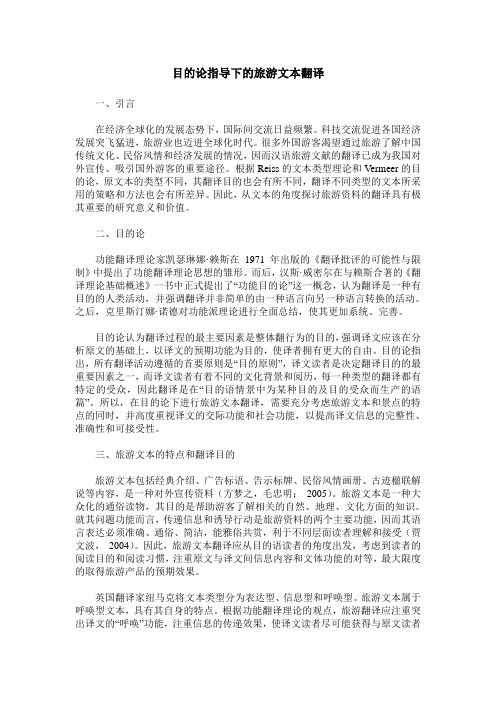
目的论指导下的旅游文本翻译一、引言在经济全球化的发展态势下,国际间交流日益频繁。
科技交流促进各国经济发展突飞猛进,旅游业也迈进全球化时代。
很多外国游客渴望通过旅游了解中国传统文化、民俗风情和经济发展的情况,因而汉语旅游文献的翻译已成为我国对外宣传、吸引国外游客的重要途径。
根据Reiss的文本类型理论和Vermeer的目的论,原文本的类型不同,其翻译目的也会有所不同,翻译不同类型的文本所采用的策略和方法也会有所差异。
因此,从文本的角度探讨旅游资料的翻译具有极其重要的研究意义和价值。
二、目的论功能翻译理论家凯瑟琳娜·赖斯在1971 年出版的《翻译批评的可能性与限制》中提出了功能翻译理论思想的雏形。
而后,汉斯·威密尔在与赖斯合著的《翻译理论基础概述》一书中正式提出了“功能目的论”这一概念,认为翻译是一种有目的的人类活动,并强调翻译并非简单的由一种语言向另一种语言转换的活动。
之后,克里斯汀娜·诺德对功能派理论进行全面总结,使其更加系统、完善。
目的论认为翻译过程的最主要因素是整体翻行为的目的,强调译文应该在分析原文的基础上,以译文的预期功能为目的,使译者拥有更大的自由。
目的论指出,所有翻译活动遵循的首要原则是“目的原则”,译文读者是决定翻译目的的最重要因素之一,而译文读者有着不同的文化背景和阅历,每一种类型的翻译都有特定的受众,因此翻译是在“目的语情景中为某种目的及目的受众而生产的语篇”。
所以,在目的论下进行旅游文本翻译,需要充分考虑旅游文本和景点的特点的同时,并高度重视译文的交际功能和社会功能,以提高译文信息的完整性、准确性和可接受性。
三、旅游文本的特点和翻译目的旅游文本包括经典介绍、广告标语、告示标牌、民俗风情画册、古迹楹联解说等内容,是一种对外宣传资料(方梦之,毛忠明;2005)。
旅游文本是一种大众化的通俗读物,其目的是帮助游客了解相关的自然、地理、文化方面的知识。
就其问题功能而言,传递信息和诱导行动是旅游资料的两个主要功能,因而其语言表达必须准确、通俗、简洁,能雅俗共赏,利于不同层面读者理解和接受(贾文波,2004)。
国外乡村旅游研究述评

资源禀赋是乡村旅游发展的基础,不同地区的农业景观、农产品、文化等资 源不同,需要充分挖掘和利用,以提高乡村旅游的吸引力和竞争力。
2、乡村旅游的规划与开发
乡村旅游的规划与开发是实现其可持续发展的关键。在规划与开发过程中, 需要遵循科学的原则,充分考虑市场需求、资源禀赋、环境保护等各种因素,制 定科学的发展战略和规划方案。同时,要注意保护当地自然环境和文化传统,避 免对环境和文化造成破坏。在实践中,可以采取政府主导、企业运作、社区参与 等多种模式,以促进乡村旅游的健康发展。
四、总结与展望
本次演示通过对国外乡村旅游的研究述评,总结了乡村旅游的定义与分类、 发展历程、影响因素、规划与开发、市场营销等方面的研究成果。这些成果对于 我国乡村旅游的发展具有重要的借鉴意义。本次演示也指出了当前研究中存在的 不足和问题,如研究方法单一、研究内容不深入等。
未来,可以进一步深化乡村旅游的研究内容,拓展研究领域,探索新的研究 方法和技术手段。例如,可以利用大数据分析等技术手段,提高研究的精度和效 率;可以深入研究游客的消费行为和需求特征,以制定更加精准的市场营销策略; 可以加强乡村旅游的可持续发展研究,探索更加环保和可持续的旅游形式;可以 推动乡村旅和启示。
国外乡村旅游研究述评
01 一、引言
目录
02 二、文献回顾
03 三、重点阐述
04 四、总结与展望
05 参考内容
一、引言
乡村旅游作为一种独特的旅游形式,近年来在国内外得到了迅速发展。特别 是在发达国家,乡村旅游已经成为了旅游产业的重要支柱之一。本次演示旨在综 述国外乡村旅游的研究成果,以期为我国乡村旅游的发展提供借鉴和启示。
总结:国外乡村旅游研究已经取得了丰硕的成果,涉及乡村旅游的发展模式、 旅游活动设计、旅游业的影响等方面。然而,还存在一些不足之处,例如缺乏深 入的理论研究和实证研究,缺乏对一些新兴的乡村旅游形式的探讨等。未来研究 可以进一步深入探讨乡村旅游发展的理论基础和实践经验,加强对新兴乡村旅游 形式的和研究,推动乡村旅游研究的国际交流与合作,以更好地指导和推动乡村 旅游的发展。
莱斯文本类型理论视角下的旅游文本英译研究——以湖南若干旅游景点英译为例
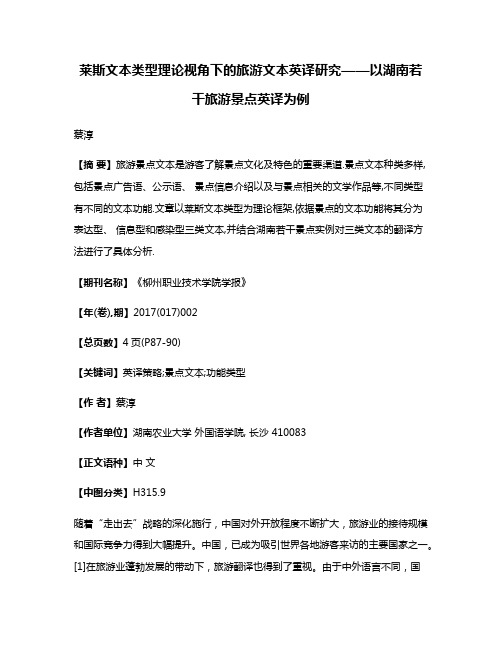
莱斯文本类型理论视角下的旅游文本英译研究——以湖南若干旅游景点英译为例蔡淳【摘要】旅游景点文本是游客了解景点文化及特色的重要渠道.景点文本种类多样,包括景点广告语、公示语、景点信息介绍以及与景点相关的文学作品等,不同类型有不同的文本功能.文章以莱斯文本类型为理论框架,依据景点的文本功能将其分为表达型、信息型和感染型三类文本,并结合湖南若干景点实例对三类文本的翻译方法进行了具体分析.【期刊名称】《柳州职业技术学院学报》【年(卷),期】2017(017)002【总页数】4页(P87-90)【关键词】英译策略;景点文本;功能类型【作者】蔡淳【作者单位】湖南农业大学外国语学院, 长沙 410083【正文语种】中文【中图分类】H315.9随着“走出去”战略的深化施行,中国对外开放程度不断扩大,旅游业的接待规模和国际竞争力得到大幅提升。
中国,已成为吸引世界各地游客来访的主要国家之一。
[1]在旅游业蓬勃发展的带动下,旅游翻译也得到了重视。
由于中外语言不同,国际游客对旅游景点的知悉往往借助于景点的文字翻译,因此,旅游景点文本的翻译质量对传播景点特色、文化起到了重要作用。
景点文本包含一切与旅游景点相关的文字文本。
景点文本类型多样,包括景点广告语、景点公示语、景点文化介绍以及与景点相关的文学作品等。
[2]景点文本翻译的服务对象是国际游客,因而在语言表达上不仅要准确、不偏离、不遗漏,还必须符合译入语的文化习惯,使外籍游客易于接受。
英语国家的景点文本大多简明扼要,语言表达直观、通俗。
[3]在对景观描写上,西方人常常是通过对客观景物的罗列来传达实实在在的景物之美,力求还原景点的原貌,让读者有一个明确而具体的印象。
汉语则不然,在景点文本表达上多用描述性语言, 讲究四言八句、言辞华美、声情并茂、虚文相生、情景相融,充满了意境美。
由此看来,中外游客对景点文本功能的诉求并不一致,译者在进行文本英译时,需考虑中西方人在文本表达方式上存在的差异,从而进行必要的功能调整,以符合读者的习惯。
国内外乡村旅游成功案例
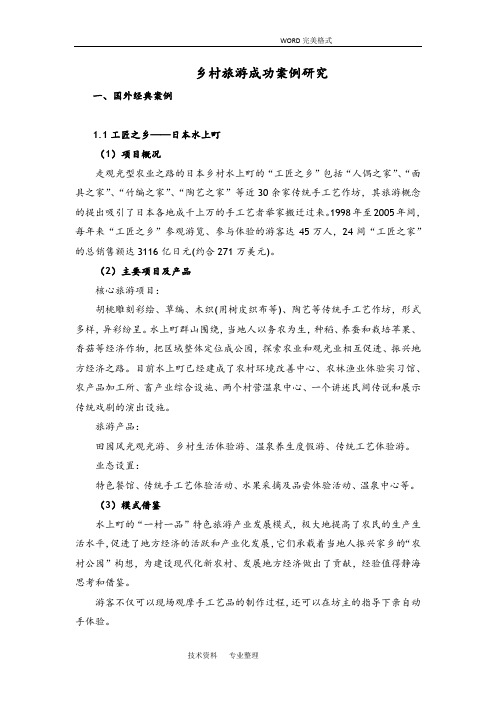
乡村旅游成功案例研究一、国外经典案例1.1工匠之乡——日本水上町(1)项目概况走观光型农业之路的日本乡村水上町的“工匠之乡”包括“人偶之家”、“面具之家”、“竹编之家”、“陶艺之家”等近30余家传统手工艺作坊,其旅游概念的提出吸引了日本各地成千上万的手工艺者举家搬迁过来。
1998年至2005年间,每年来“工匠之乡”参观游览、参与体验的游客达45 万人,24 间“工匠之家”的总销售额达3116 亿日元(约合271 万美元)。
(2)主要项目及产品核心旅游项目:胡桃雕刻彩绘、草编、木织(用树皮织布等)、陶艺等传统手工艺作坊,形式多样,异彩纷呈。
水上町群山围绕,当地人以务农为生,种稻、养蚕和栽培苹果、香菇等经济作物,把区域整体定位成公园,探索农业和观光业相互促进、振兴地方经济之路。
目前水上町已经建成了农村环境改善中心、农林渔业体验实习馆、农产品加工所、畜产业综合设施、两个村营温泉中心、一个讲述民间传说和展示传统戏剧的演出设施。
旅游产品:田园风光观光游、乡村生活体验游、温泉养生度假游、传统工艺体验游。
业态设置:特色餐馆、传统手工艺体验活动、水果采摘及品尝体验活动、温泉中心等。
(3)模式借鉴水上町的“一村一品”特色旅游产业发展模式,极大地提高了农民的生产生活水平,促进了地方经济的活跃和产业化发展,它们承载着当地人振兴家乡的“农村公园”构想,为建设现代化新农村、发展地方经济做出了贡献,经验值得静海思考和借鉴。
游客不仅可以现场观摩手工艺品的制作过程,还可以在坊主的指导下亲自动手体验。
“工匠之乡”以传统特色手工艺为卖点,进行产业化发展和整体营销,提供产品生产的现场教学和制作体验,大力发展特色体验旅游,获得了极大的成功。
带动区域经济发展,地方经济添活力。
农业与观光相结合的模式促进了地方经济的活跃,使居民们获得了实惠。
居民观念大转变,当地土生土长的匠人不仅感受到了家乡面貌的变迁,还感慨于人们观念和意识的转变。
1.2薰衣草的国度——法国普罗旺斯乡村旅游(1)发展现状法国南部地中海沿岸的普罗旺斯不仅是法国国内最美丽的乡村度假圣地,更吸引来自世界各地的度假人群,到此感受普罗旺斯的恬静氛围。
[word doc]国外旅游度假区研究综述
![[word doc]国外旅游度假区研究综述](https://img.taocdn.com/s3/m/05b8e414680203d8ce2f24f9.png)
[word doc]国外旅游度假区研究综述国外旅游度假区研究综述第3卷第4期2010年8月Vo1.3No.4Aug.,2010[旅游业研究]国外旅游度假区研究综述’朱芳,苏勤(安徽师范大学国土资源与旅游学院,安徽芜湖241003)[摘要]度假旅游起始于欧洲,现已成为世界旅游市场发展的一大趋势.作为度假旅游的产物——旅游度假区,也受到国外学者们的关注通过对国外相关书籍和期刊文献的分析,发现国外研究焦点集中在旅游度假区发展模型,旅游度假区市场特征,旅游度假区影响以及旅游度假区经营管理四个方面.在研究方法上大多以发展成熟的度假区为例,运用定性与定量相结合的方法进行分析.对国外四个研究焦点以及研究方法进行分析,以期为中国旅游度假区的健康发展提供借鉴.[关键词]度假旅游;旅游度假区;研究焦点;研究综述[中圉分类号]F592[文献标识码]A[文章编号]1674—3784(2010)04—0453—06 欧洲是度假旅游的发源地.早在2O世纪初,随着经济的增长和交通的发展,越来越多的人就已倾向于把闲暇时间用于以健身,放松,休闲,娱乐为目的的度假旅游.度假旅游的发展势必带动旅游度假区的兴起.关于旅游度假区的定义,国外学者争议颇多,其中EdwardInskeep[1]认为,旅游度假区是一个相对自给自足的(Self—Contained)目的地,是为满足游客娱乐,放松需求而提供的可以广泛选择的旅游设施与服务.二次大战以前,度假区的类型以温泉浴疗为主;二战后,随着地中海度假区的兴起,阳光,沙滩和海洋的“3s”型开始盛行;8O年代以后,由于地中海一带环境的破坏,同时人们的自我参与意识增强,度假区的类型开始转向运动式.度假旅游的市场特征要求旅游度假区依托良好的旅游资源环境,集中满足旅游者食, 住,行,游,购,娱等多方面的需求,是一种投入产出大的旅游开发形式,因此,西方学术界对旅游度假区的研究越来越关注.作为一种特殊的旅游产品,旅游度假区的重要作用已得到了普遍认同.本文通过对国外相关书籍和期刊文献的分析,发现在度假旅游蓬勃发展的背景下, 旅游度假区也得到了空前的发展.国外对旅游度假区的研究主要涉及以下4个方面:旅游度假区发展模型,旅游度假区市场特征,旅游度假区影响研究以及旅游度假区经营管理.一,国外旅游度假区研究焦点(一)旅游度假区发展模型从20世纪中期开始,学者们开始关注旅游度假区的演化发展.Barrett[2]通过对滨海旅游地的深入分析,研究了不断变化的海滩度假区的形态,总结出滨海度假区的基本线性结构,认为度假区内各项旅游设施趋向于集中布局.Miossec[33从空间结构的角度出发,研究了目的地旅游开发演化推进过程,并建立了度假区等级演化的模型.随后,Pigram[分析并总结了沙滩度假区的形态.在度假区的发展模型中,巴特勒的生命周期模型引起了最广泛的关注,很多学者开始选择不同的案例地,从不同的视角来验证该模型,出现了生命周期模型的实证研究热潮.1.旅游度假区生命周期模型的实证研究巴特勒的六阶段模型提出以后,学者们的实证研究结果形成三种观点,有支持生命周期模型观点的,也有认为其并不能充分说明旅游业演变的,还有在生命周期模型的基础上进行修正补充的,具体见表1.自1980年巴特勒提出生命周期模型后,其六阶段模型被视为用于度假区开发的最重要的模式,且该模型在很多地方都被检验过n.生命周期模型可以作为一种分析框架,用来审查旅游目的地在复杂的经济,社会和文化环境中的演变Ll3虽然巴特勒的生命周期模型受欢迎已有二十多[基金项目]安徽省人文社科基地重大研究项目(编号:2005sk069);2008年度省领导圈定课题(编号:SLQDKT0806)[收稿日期32oiO-Ol一15[作_者简介]朱芳(1986一),女.安徽安庆人,安徽师范大学国土资源与旅游学院2008级旅游管理硕士研究生,主要从事度假旅游与旅游规划研究;苏勤(1964一),男.安徽安庆人,安徽师范大学国土资源与旅游学院教授,博士生导师,主要从事旅游规划与管理,区域经济研究.453年,但仍然表现出一些弱点,限制了它作为一种分析工具的效用的发挥[1纠.Agarwal[16]提出,尽管大量的研究审查度假区生命周期,但其有效性,适用性和普遍性尚未得到成功验证,SheelaAgarwalL1研究度假区生命周期模型在不同目的地的适用性中,在确切形状和图案曲线以及详细的参数上产生了很多的争议.表1国外学者关于巴特勒生命周期模型的观点观点案例地/视角作者举例支持路易斯安那州大岛度假区Meyer--Arendt.K.J(1985)加勒比群岛地区Sauble海滨Paradise岛英国马恩岛反对兰卡斯特县大开曼群岛补充/修正市场运作方式经济地理学(资料来源:根据所参考文献[5]一[133整理而得)随后又有一些学者从不同的角度提出了度假区发展的新模式,如,BrucePrideaux[1.]基于市场运作方式,从需求和供给角度出发,提出度假区发展的新模式——度假区发展谱,将度假区的发展分为当地旅游,区域旅游,国内旅游,国际旅游,衰落/停滞/复兴5 个阶段,并总结了每个阶段的主要特点;Andreas[?] 从经济地理学的角度探讨了旅游度假区的进化模式, 提出了一个在市场和空间结构中内生变化的新模型, 生动说明了市场和空间力量的互动,解释了发展的因果机制,并预测发生在不同演变阶段的转折点.总之, 度假区的时机和发展速度都是大不相同的,因此,地域范围内生命周期模型的成功应用是有限的[1.2.旅游度假区再生研究根据巴特勒的生命周期模型,旅游度假区经过各阶段的发展后会到达衰落阶段.而事实也证明,在经过几十年的发展后,西方国家的旅游度假区也都处于巴特勒所说的停滞或衰落期.于是,如何保证度假区的再生已成为学者们所关注的热点.Gerda PriestleyLl8J以加泰罗尼亚沿岸LloretdeMar,l2 Estartit,Sitages3个度假区为例,通过需求的停滞, 超过承载能力,住宿开始不能满足大众旅游的需求等特征的显现确定其”停滞阶段”的到来,提出一种新的度假区发展替代模式:分别描绘出旅游业增长对自然环境,建筑环境的影响及改革进程模式,基本标准是454增长的速度和最高的发展水平必须保持在环境可持续发展前提下.SheelaAgarwal[认为,经济结构调整导致了沿海地区大众旅游的普遍下降,这种下降影响了以大众旅游为依赖的地方和区域的经济,为制止当地的经济衰退和对滨海旅游业的影响,英国当局提出旅游业发展行动计划(TDAP).通过对英国西南部启动TDAP的度假区的3年复兴计划成就的调查,发现复兴计划在产品改进,经营业绩,就业等方面均未促进地方经济发展,这是因为两个潜在的重要因素被忽视了,即跨组织合作和资金支撑.滨海旅游复兴存在两个主要问题,首先是由于旅游行为模式开始显示出对大众沿海旅游产品的厌倦[2,新的目的地的出现和不同形式假期的发展使得旅游者的愿望和期望发生改变.其次,虽然旅游产品可能会被操纵,更换和重新定位,但是它们也可能被其他竞争地复制,同时, 由于旅游品味和偏好的变化,它们又不可避免地成为过时和不合时宜的,这种不断变化的需求使得旅游地开始进行结构重组,不断创新再生战略[1引.旅游度假区的再生是一个持续的过程,必须不断地重新定位和振兴自己的产品,以便跟上竞争地和市场不断变化的步伐.3.旅游度假区演进过程中特点的研究为了更好地理解旅游度假区的演化发展,对其演化过程中所显现的特点的研究也是不可或缺的. Cohen[21]从社会学的角度出发,探讨了在度假区发展过程中游客心理需求的变化;Smith[..]研究了游客在度假区经过一段时间后个性的变化;Konstantinos Andriotis[..]探讨了希腊克里特岛形态变化的特征, 在试图分析沿海度假地的形态改变时,发现了最重要的3个因素:客体(谁是发展的主要推动力);主体(谁为支持发展和参与旅游业的成功作出贡献)和政治(影响整体发展).(--)旅游度假区市场研究随着社会发展和需求的变化,对度假区市场的研究也在不断的深化.初期的研究结果认为:度假区的主要客源市场是度假旅游者,奖励旅游者,会议旅游者及康复医疗者[2.在7O,80年代,度假区的开发主要是面向豪华或上层收入市场,但目前这种趋势已经改变,更多的学者认为,度假区的市场应面向中低收入的国际旅游市场和区域旅游市场.同时,市场研究的重要性也被学者们所认同,Kye—SungChon[25]的研究也表明:只有那些意识到市场的变化以及积极响应这些变化的度假区才会继续获得未来的成功.另外,今后的度假区将实施集中的营销策略,并为顾客一蚴?,一一,一,,一一,一,,,,,,一二薹提供积极的产品价值.至此,学者对度假区市场的研究也更加的细化,深入.Kye—SungChon[.5]重点介绍了美国度假区产业在20世纪90年代以来的主要趋势,并讨论了其对度假区未来市场的影响;NeilCarr[26]根据英国西南部以海滩为导向的度假区年轻游客假日休闲行为的资料,发现青年旅游者的休闲活动很少有性别差异; LluisMundet~..1uisRibera[]以玛代群岛为例,发现来此潜水的游客基本为31—45岁的中年男子,主要来自法国和加泰罗尼亚,以专业男性和中等偏高学术背景的人为主,且玛代群岛的传播主要是口口相传.(三)旅游度假区影响研究第二次世界大战后,人们的收入和闲暇时间得到了空前增长,特别是有法律保障的带薪假期的不断增加,为人们大规模外出度假创造了极好的条件[2引.在欧洲,度假旅游已成为一种实实在在,势不可挡的世纪”潮流”,与此同时,度假旅游者和度假区开发管理者的行为也对区域经济,社会,环境,政治等方面产生了一定的影响,于是,度假区影响也成为国外学者研究的重要问题.旅游度假区的发展给当地带来的影响有积极的一面,也有消极的方面,具体见表2.表2旅游度假区的发展对当地的影响(根据所参考文献[29]一[35]整理而得)自1985年墨菲(P.E.Marphy)在其着作《旅游:社区方法》一书中首次引入社区参与的概念以来,目的地居民的权益和对待旅游的态度开始被业界重视,度假区的发展对当地居民所造成的影响也越来越受到学者们的关注.如,SigferdoA~HectorLC..]采用社会交换理论,旅游业发展的周期理论以及分割的办法3个概念框架讨论了度假区居民对旅游业的态度. Renata~t3illE.]根据马斯洛需要层次论制定分析框架,发现黄金海岸老年居民能更宽容地对待旅游业的影响,没有特别容易受到负面影响;而其余人群对旅游业感到不便,主要是不满足现有的利益分配机制. Teodoro~MariaL3胡的研究揭示了西班牙比利牛斯山滑雪度假区旅游业的发展对当地人口(居民人数和人口结构)以及主要的生产活动(农业和牲畜)的影响【3引,其中对人口的演变是积极的影响,而对主要部门则是负面影响.度假区的发展对当地方方面面的影响也要求管理者注重度假区有限的承载力,而度假区的承载力又是由一个地方的具体因素所确定的组合力量,包括环境因素,土地供应,社会愿望,知觉(心理)等组成部分[3.只有在度假区承载能力范围之内,才能实现旅游业与社区的可持续发展.(四)旅游度假区经营管理研究旅游度假区的开发建设需要大量人力,资金方面的投入,所以,经营者们非常重视对度假区的管理,以便更快地回收资金.国外学者对度假区的管理的研究也日益细化,如在提供服务方面,MatthiasEo]建立了一个多属性测量模型,用于评估高山滑雪度假区的服务质量和游客满意度;在目的地竞争力管理方面, Anne—MarieL4妇以Foxwoods赌场度假区为例,认为其成功和经济增长的关键是拥有富有远见的企业家和战略管理;在管理工具方面,度假地开始认识到”绿色”行动正在迅速成为企业的当务之急,生态旅游也为那些愿意遵循总体规划的生态度假区提供了经济机会[4.Jan8elanieE.]的研究结果也显示,目前关注的焦点是业内管理绿色认证计划,其作用是作为一个关键工具,以促进生态度假区的可持续发展;在门票455价格制定方面,国外学者在方法的运用上也不断推陈出新,如享乐价格分析法,即经常被用来量化住房所包含的属性和住房价格的关系,享乐价格分析更容易辨别出哪些特点是被消费者所重视以及重视的程度. Martin[*t]从门票价格与滑雪度假区细分评价因素的关系角度出发,运用享乐价格模型估算出奥地利各种滑雪度假区滑雪者愿意支付的门票价格,发现其中一些因素如造雪能力,运输能力,电梯设施的质量,滑雪场的大小,提供多种滑雪场的通行证尤为重要;在文化,环境的保护方面,Gorazd&Tanja[453指出,真实性已成为旅游者选择海滨度假胜地的一个重要因素,强调管理方应重视对目的地环境的保护.在对度假区进行经营管理中,积极倡导分时度假(TimeShare)的经营模式.分时度假的理念自2O世纪6O年代末期引入到旅游业中以来,就已在度假区等旅游目的地迅速发展起来,目前已成为国际旅游度假区经营的一种趋势.这种经营方式对于度假区来说,既可以较快地收回投资,又可以解决度假区淡旺季所导致的设施季节性闲置问题.度假地管理是一项具有挑战性的工作,如何在旺季平衡分时度假产品所有者的权益和前来参观人员的数量,或者如何在淡季降低不必要的使用都是一门学问[4引.因此,对分时度假产品管理的研究还有待深入.二,国外旅游度假区的研究学科理论及方法国外学者对旅游度假区的探讨主要是运用社会学,地理学,经济学,管理学,心理学的相关研究方法,具体来说,是以访谈法(着重采用深入访谈法),问卷调查法,统计法,图表法,比较法等为主.国外学者关于旅游度假区的研究方法及涉及学科理论如表3所示.表3国外旅游度假区研究学科理论及方法涉及学科理论研究学者研究方法案例地及数据来源主要结论地理学BarryWorthington历史叙述法爱沙尼亚度假区,首先,度假区的发展得益于运输网络的变化;其次,必须考虑战略地位的重要性,包括生命周期理论(2003)[~73过渡路径分析发展历史资料成本差异和主要市场的关系.GorazdSedmak联合分析法斯洛文尼亚皮兰市,在4O家酒真实性已成为游客选择海滨度假地最重要社会学店随机抽样18岁以上游客300的一个因素,影响真实性的因素主要是土生(2008)E463(交互分析)名土长的自然环境,其次是特色菜肴和饮料.心理学马斯洛需要RentaTomljenorie面谈法澳大利亚黄金海岸,回收有效问黄金海岸的老年居民已适应了旅游业,而其(2000)E37]卷370份,其中老年居民169份余人群对旅游业的不满源于利益分配问题.层次理论由本地导游和游客的互动形成的旅行的地HeidiDames,Karin日惹,龙目岛,1994—1996年期方是可以研究的领域,作者认为,在工作中人类学田野调查Bras(1999)[35]间每个地方调查5O名导游.应遵守”本地指南”,提供有关景点的信息,讲故事,并与游客进行互动.地理学SigfredoA.Hernan经济影响:重旅游业的成本和利益,忽视生生命周期理论deZ.JudyCoherl,分割法波多黎各伊莎贝拉的居民,1991态环境;社会影响:重生活环境的宁静部社会学HectorL.Garcia深入访谈法年8月为期三周.调查对象43名社会交换理论(1996)Eae]分.经济学MartinFalk享乐价格WWW.bergfex.toni中搜索到奥估算出奥地利滑雪度假区滑雪者愿意支付地利总坡长大于5公里的滑雪的门票价格,其中造雪能力,运输能力,电梯享乐价格理论(2008)5]分析法质量,滑雪场的大小,提供多种滑雪场的通度假区84个行证等因素尤为重要.其市场特征为:3l一45岁的中年男子.主要LluisMundetLluis玛代群岛,1998年7月至1999年来自法国和加泰罗尼亚,具中等偏高学术背市场学问卷调查Ribera(2001)[27]6月共调查500名潜水员景,潜水经验丰富,重访度假区是由于丰富海洋生物的吸引.英国西南部托基海滨度假区,青年旅游者的度假动机无明显性别差异,这问卷调查深入1995年夏共调查200名游客;深NeffCarr(1999)[26]两个群体选择度假的最重要原因是希望”放访谈法入访谈调查了3名女性,5名男性.松”和”享受生活”.456国外研究大多数以发展成熟的度假区为例,着重采用第一手数据资料进行研究,以定量的研究结果支撑定性的描述,运用多学科综合研究方法,构建相关模型,辅以实例进行验证,使其研究结果更具深入性和科学性.三,评述与启示通过综合分析,笔者发现,国外学者对旅游度假区的研究较为深入,细化,其研究焦点主要集中在四个方面:旅游度假区发展模型,旅游度假区的市场特征,旅游度假区的影响以及旅游度假区的经营管理等方面.而旅游度假区的发展模型又是其中最为热门的一个话题,国外学者对此也进行了深入的探讨.可见, 国外关于旅游度假区的研究已相当完善,而国内学者对旅游度假区的研究,大多还停留在定性描述方面, 在研究中缺乏对方法的综合运用.我国自1992年经国务院批准创办了首批12个国家级旅游度假区以来,其发展情况不容乐观.笔者认为国外旅游度假区的研究在以下几个方面值得借鉴.(一)在旅游度假区发展模型方面国外学者侧重于研究旅游度假区的发展阶段,再生以及演进过程中所显现的特点等问题,根据巴特勒的生命周期模型,西方国家大部分度假区都面临着衰退的问题.学者们通过进行大量的实地调查,根据各度假区的特点制定出适合各自发展的道路,国外学者综合考虑了案例地的住宿,交通,市场,经济等外部环境,指出度假区在各发展阶段上的制约因素,从而为度假区的健康发展提供了理论上的指导.参考文献:1,13EdwardInskeep.TourismPlanning:anintegratedandsustainable developmentapproach[M].NewYork:VanNostrandRein--Hold,1991.[23Barrett.J.A.TheseasideresorttownsofEnglandandWales1,D].Pb.n thesis.UniversityofLondon.1958.[33Miossec.J.M.ElementspouruneTheoriedelEscapeTouristique[M]. LesCahiersDuTourisme,C一36.CHET,Aix—en—Provence,1976.[4]PigramJJ.Beachresortmorphology[J].Habitatinternational,1997.2: 525—541_[5]Meyer--Arendt.K.J.TheGrandIsle,Lousianaresortcycle1-J].Annalsof TourismResearch.1985,12t3):449—465.[6]Wilkinson.P.Tourisminsmallislandnations:afragiledependence[J]. LeisureStudies+1987,26t2):l27一l46.[73JamesD.Strapp.Theresortcycleandsecondhomes[J].Annalsof516. TourismResearch,l988.15(4):504—[8]KeithG.,Debbage.OligopolyandtileresortcycleintheBahamas1’J]. AnnalsofTourismResearch.1990,I7(4):5l3—527.[9]SvendLundtorl,.BillFaulkner.TheResortLifecycleTheory,一一GeneratingProcessesandEstimation[J].AnnalsofTourisnlResearch?20O1.28():947—961.(二)在市场分析与经营管理方面旅游度假区的市场定位应改变最初的高端市场的构想,因为中低收入的国际旅游市场和区域旅游市场才是今后的主导,对度假区细分市场的研究有助于度假区正确的定位,良性的发展,进而采取积极有效的管理措施.旅游度假区的经营管理与一般酒店存在着很大的差别,分时度假模式是今后经营的一个趋势,如何有效地经营管理旅游度假区仍然是一个有待讨论的话题.(三)在旅游度假区影响方面旅游度假区的大规模投入给目的地也带来了很大的影响,这些影响涉及到经济,社会文化,环境,政治等方面,国外学者关注度假区的建设对当地居民的影响,并对此进行了深入的分类研究.只有充分认识到旅游度假区的建设与发展给当地带来的积极和消极方面的影响,才能正确地处理各方之间的关系,及时采取措施,真正实现和谐发展与利益最大化. (五)在研究方法方面国外学者对旅游度假区的研究不仅包括基础理论的介绍,更多的是以发展成熟的度假区为例,如中美洲的加勒比海,地中海和东亚及太平洋地区等,采用多学科研究方法,以定性和定量相结合进行分析,使研究结果更具说服力.而我国关于旅游度假区的研究大多还停留在定性描述阶段,采用的研究方法较为单一,在今后的研究中,应注重以某一度假区或某一类度假区为研究对象,综合运用社会学,经济学,人类学等相关学科的研究方法,进行更为深入细致的研究.[1O3Hovinen,G.R.AtouristcycleinLancasterCountry,Pennsylvania[?. CanadianGeographer,1981,25(3):283—286.[113Weaver,D.B.GrandCaymanIslandandtheresortcycleconcept[J]. JournaIofTraveIResearch.1990,29(2):9—15.[12]BrucePrideaux.Theresortdevelopmentspectrum——anewapproachto resortdevelopment[J].TourismManagement.2000,21(3):225—240.[13]AndreasPapatheodorou.ExploringtheenvolutionoftourismresortsEJ]. AnnalsofTourismResearch,2004.31(1):219—237.1-14]Tooman,L.A.Applicationsofthelife—cyclemodelintourism[J]. AnnalsofTourismResearch.1997,24(1):214—234.[15]Cooper.C.P.,Jackson,S.Destinationlifecycle:TheIsleofmancase study[J~.AnnalsofTourismResearch.1989.16(3):377—398.[163Agarwal,S.J.Theresortcycleandseasidetourism[J].Tourism Management,1997-18(2):65,74.1,17]SheelaAgarwa1.Theresortcyceandseasidetourism:anassessmentof itsapplicabilhyandvalidity[J],TourismManagement,1997+18(2)=65—73.[I8]GerdaPriestley,LluisMundet.ThePost--Stagnationphaseoftheresort cycle[J].AnnalsofTourismResearch.1998,25(1):85—1l1457[19]SheelaAgarwa1.Restructuringandlocaleconomicdevelopment: implicationsforseasideresortregenerationinSouthwestBritain[J]. ToufismMansgement?1999?20:51l一522.[20]Gomez,M.J.,Rebollo,F.V.Coastalareas:Processes,typologiesandpr0spects——lnEuropeantourism:Regions,spaceandrestructuring[J].Chichester:Wiley.1995,l11—126.[21]CohenE.Towardsasociologyofinternationaltourism[J].SocialResearch,1972,39:】64—182.Ezz]SmithV.HostsandGuests:TheanthropologyofTourism[M].Penarlvania:UniversityofPennsylvaniaPress,1977.[23]KonstantinosAndriotis.Hosts,GuestsandPolitics--一--Coastalresortsmorphologicalchange[J].AnnalsofTourismResearch,2006,33(4):1079——1098.[24]邹统钎.旅游度假区发展规划[M].北京:旅游教育出版社.1996,4:210—2l1.[25]Kye--SungChon,AmrikSingh.Marketingresortsto2000:reviewoftrendsintheUSA口].TourismManagement,1995,16(6):463—469.[26]NellCarr.Astudyofgenderdifferences:youngtouristbehaviourinaUKcoastalreaort[E.TourismManagement,1999,20:223--228.[27]LluisMundet,LluisRibera.CharacteristicsofdiversataSpanishresortD].TourismManagement.2001,22:501--510.[283田玉堂.度假村的理念与操作实务[M].北京:中国旅游出版社,2003,2;25—27.[29]Barbier.B.ProblemsoftheFrenchwintersportresorts[J].Tourism RecreationResearch.1993,18t5一l1.[3o3SamuelSeongeseopKim,BrucePrideaux.Tourismpeace,politicsand ideology:ImpactsoftheMt.GumgangtourprojectintheKoreanPeninaula[J].TourismMansngement,2003.24:675—685.[31]Benthem,R.Recreationalandenvironmentalplanning[J].Biological Conservation,l973,521—5.[32]Pignatti,s.ImpactoftourismonthemountainlandscapeofcentralItalyD].LandscapeandUrbanPlanning,1993,24:49—53.[33]Gil1.A,Williams.P.Managinggrowthinmountaintourismcommunities [J].TourismManagement,1994,15:212—220.[s43Billet.P.LecontroledeI’urbanisationdanaleszonesdemontagne口]. Bull etind’AssociationdeGeographesFrancaises,2003,1:31—43.[35]HeidiDaMes,KarinBras.Entrepreneursinromance一一一Tourismin IndonesiaEJ].AnnalsofTourismResearch.1999.26(2)l267--293.[36]SigfredoA.Hernandez.JudyCohen,HectorL.Garcia.Residents’ AttitudesTowardsaninstantresortenclave[J].AnnalsofTourism Research,1996,23(4):755—779.[37]RenataTomljenpvic,BillFaulkner.Tourismandolderresidentsina sunbeltresort[J].AnnalsofTourismResearch.2000t27(I)l93—114. [38]TeodoroLasanta,MariaLaguna,SargioM.Vicente—Sarrano.Do tourism—basedskiresortscontributetothehomogeneousdevelopmentof theMediterraneanmountains?AcasestudyintheC.entraISpanishPyrenees[J].TourismManagement,2007,28:13.6—1339.[39]Wal1.G.Cyclesandcapacity:Acontradictioninterms?[刀.Annal3of TourismResearch.1983,10(2):268--270.[4o]KlausWeiermair,MatthiasFuchs.Measuringtouristjudgementon servicequality[J].AnnalsofTourismResearch,1999.26(4):1004—102l_[41]Anne--Maried’Hauteserre.Lessonsinmanageddestination competitiveness:thecaseofFoxwoudsCasinoResort[J].Tourism Management.2000,21:23—32.[423MadeleineE.Pullman,GaryM.Thompson.Evaluatingcapacity——anddemand—managementdecisionsataskiresort[J].TheCornellHotel andRestaurantAdministrationQuarterly.2002,43(6):25—36.[43]HanaAyala.Resortecotourism;Amasterplanforexperience management[J].TheCornellHotelandRestaurantAdministration Quarterly,l996,37(5):54,61.[44JJanWarnken.MelanieBradley,ChrisGuilding.Eco—resorts. mainstreamaccommodationproviders:aninvestigationoftheviabilityof benchmarkingenvironmentalperformance[J].TourismManagement, 2005,26:367—379.[45]MartinFalk.Ahedonicpricemodelforskilifttickets[J].Tourism Management.2008,29:1172—1184.[46]GorazdSedmak,TanjaMihalic.Authenticityinmatureseasideresorts [J].AnnalsofTourismResearch.2008,35(4):lO07—1031.[47]SarahRezak.Consumerresearchshedslightonallaspectsofresorttimesharingbusiness[J].HospitalityManagement,2002,21l245--255.[48]BarryWorthington.ChangeinanEstonianresort一一一Contrastingdevelopmentcontexts口].AnnalsofTourismResearch,2003,30(2);369——385.AReviewofStudyonForeignTouristResortZHUFang,SUQin(CollegeofTerritorialResourcesandTourism,AnhuiNormalUniversity,Wuhu2 41003,China)Abstract:Holiday-MakingTourismoriginatedfromEurope,hasbecomeatrendofworldtourismmarketdev elopment.Asaproductoftheriseofholiday——makingtourism——————touristreso rt.hasalsobeenconcernedbyforeignscholars.Thepaper.afterreviewingtherelevantforeignbooksandliterature,andfoundedthatove rseasresearchfocusedon:touristresortdevelopmentmodel,touristresortcharacteristicsofmarket.studyoftourist resortsimpactsaswellasbusinessmanagementoftouristresort.Ontheaspectofresearchmethods.mostoftheresearchtakethed evelopedtouristresortforexample,usingacombinationofqualitativeandquantitativemethodsforanalysis.Inthispape r,bytheanalysisofthefouraspectsonforeignreseachaswellasthemethods.itaimstoprovidereferenceforthehealthydevel opmentofChinastouristresort.Keywords:holiday--makingtourism;touristresort;studyfocus;studyrevie w458[责任编辑:吕观盛]。
国外乡村旅游研究及对我国的启示_基于我国乡村旅游发展现状的思考
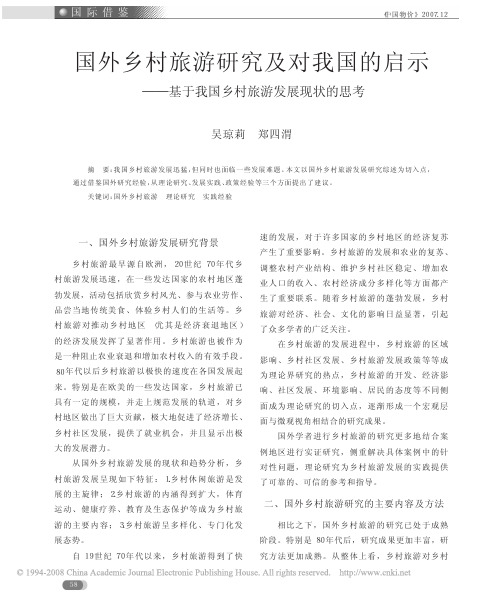
《中 国 物 价 》2 0 0 7 .1 2
国外乡村旅游研究及对我国的启示
— ——基于我国乡村旅游发展现状的思考
吴琼莉 郑四渭
摘 要: 我国乡村旅游发展迅猛, 但同时也面临一些发展难题。本文以国外乡村旅游发展研究综述为切入点, 通过借鉴国外研究经验, 从理论研究、发展实践、政策经验等三个方面提出了建议。
4. 乡村旅游发展的战略规划、管理和市场营 销方面研究
在较早发展乡村旅游的国家和地区, 对于乡 村旅游规划、管理模式、市场营销问题较为关 注。 譬如 Jackie Clarke 等就斯洛伐克东部地区的 乡村旅游三年发展计划展开了论述, 在发展规划 中, 市场营销被作为一个重点而进行。
5. 乡村旅游者研究 随着现代乡村旅游的发展, 旅游主体人群、 需求结构、消费结构等发生着变化, 需求的变化 必然导致供给的调整。在供给需求研究中, 研究 的侧重点在于对游客行为动机和行为模式的分析 研究。目前, 国外对于乡村旅游者的研究, 得出 一些共同的特征: 游客以中青年者为主, 具有中 等及中等以上的职业及收入水平, 消费能力较强; 多为短途旅行, 交通方式以自驾车为主; 旅游者 的重游率较高等。Lourdes Molera 等对西班牙东南 地区的乡村旅游者进行了深入的研究, 得出了进 行市场选择的观点。Martin Oppermann ( 1996) 对 德国南部乡村旅游的研究中, 主要研究旅游者特 征对乡村旅游的影响。 6. 实证研究 在国外大量的乡村旅游的有关文献中, 主要 是结合案例对乡村旅游发展进行调查研究。 在实证研究中, 学者结合具体案例解决发展过程 中的具体问题, 并不是就乡村发展泛泛而谈, 更 具有实践的指导意义。如 Richard Sharpley 对塞浦 路斯的 研 究 中 主 要 就 政 府 旅 游 组 织 ( CTO) 展 开
国外乡村旅游研究综述

国外乡村旅游研究综述一、本文概述随着全球化和城市化的快速发展,乡村旅游在全球范围内逐渐兴起,成为了一种重要的旅游形式。
本文旨在全面综述国外乡村旅游的研究现状,分析其主要研究内容、方法和成果,以期为我国乡村旅游的发展提供借鉴和参考。
本文首先介绍了乡村旅游的基本概念、特点和发展背景,阐述了乡村旅游在全球旅游业中的地位和作用。
随后,本文分别从乡村旅游的经济影响、社会文化影响、环境影响、规划与管理以及可持续发展等方面进行了详细的综述。
在综述过程中,本文重点关注了国外乡村旅游研究的理论框架、研究方法、数据来源以及主要结论,同时也指出了现有研究中存在的不足之处和未来研究的展望。
通过本文的综述,可以发现国外乡村旅游研究已经形成了较为完整的理论体系和研究方法,其研究内容涵盖了乡村旅游的多个方面,包括经济、社会、文化、环境等多个领域。
这些研究成果不仅为我们深入了解乡村旅游的本质和特征提供了重要的理论依据,同时也为乡村旅游的规划和管理提供了重要的指导。
然而,现有研究仍存在一些不足,如研究方法的多样性、数据来源的可靠性以及研究结论的普适性等方面的问题。
因此,未来的研究需要在这些方面进行进一步的探索和改进。
本文旨在通过综述国外乡村旅游的研究现状,为我国乡村旅游的发展提供有益的参考和借鉴。
本文也期望能够引起更多学者对乡村旅游的关注和研究,共同推动乡村旅游的可持续发展。
二、国外乡村旅游的发展历程乡村旅游在全球范围内的发展,可以追溯至19世纪中叶的欧洲。
当时,随着工业革命的推进和城市化进程的加快,城市居民开始寻求逃离城市喧嚣,寻找乡村的宁静与自然之美。
这种需求推动了乡村旅游的初步发展。
进入20世纪,特别是二战后,随着经济的复苏和人们生活水平的提高,乡村旅游逐渐成为一种流行的休闲方式。
此时的乡村旅游主要以观光和度假为主,游客可以欣赏乡村的自然风光,体验乡村的生活方式。
20世纪70年代,随着全球范围内环境保护意识的增强,乡村旅游开始注重可持续发展,强调对乡村环境和文化的保护。
国外乡村旅游模式成功案例
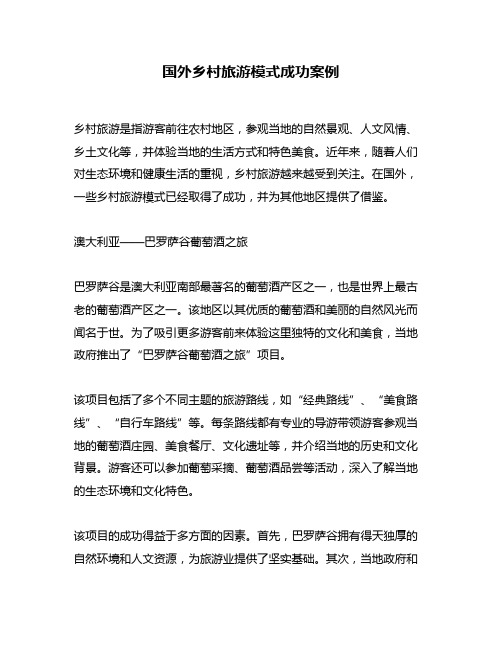
国外乡村旅游模式成功案例乡村旅游是指游客前往农村地区,参观当地的自然景观、人文风情、乡土文化等,并体验当地的生活方式和特色美食。
近年来,随着人们对生态环境和健康生活的重视,乡村旅游越来越受到关注。
在国外,一些乡村旅游模式已经取得了成功,并为其他地区提供了借鉴。
澳大利亚——巴罗萨谷葡萄酒之旅巴罗萨谷是澳大利亚南部最著名的葡萄酒产区之一,也是世界上最古老的葡萄酒产区之一。
该地区以其优质的葡萄酒和美丽的自然风光而闻名于世。
为了吸引更多游客前来体验这里独特的文化和美食,当地政府推出了“巴罗萨谷葡萄酒之旅”项目。
该项目包括了多个不同主题的旅游路线,如“经典路线”、“美食路线”、“自行车路线”等。
每条路线都有专业的导游带领游客参观当地的葡萄酒庄园、美食餐厅、文化遗址等,并介绍当地的历史和文化背景。
游客还可以参加葡萄采摘、葡萄酒品尝等活动,深入了解当地的生态环境和文化特色。
该项目的成功得益于多方面的因素。
首先,巴罗萨谷拥有得天独厚的自然环境和人文资源,为旅游业提供了坚实基础。
其次,当地政府和企业积极推动乡村旅游发展,并注重保护生态环境和文化遗产。
最后,专业的导游和优质的服务也为游客提供了良好的旅游体验。
法国——普罗旺斯薰衣草之旅普罗旺斯是法国南部最美丽的地区之一,以其广袤的薰衣草田、迷人的小镇和优质的葡萄酒而闻名于世。
为了吸引更多游客前来欣赏这里独特的自然风光和文化遗产,当地政府推出了“普罗旺斯薰衣草之旅”项目。
该项目包括了多个不同主题的旅游路线,如“薰衣草路线”、“古镇路线”、“美食路线”等。
每条路线都有专业的导游带领游客参观当地的薰衣草田、古镇、美食餐厅等,并介绍当地的历史和文化背景。
游客还可以参加薰衣草采摘、美食品尝等活动,深入了解当地的生态环境和文化特色。
该项目的成功得益于多方面的因素。
首先,普罗旺斯拥有得天独厚的自然环境和人文资源,为旅游业提供了坚实基础。
其次,当地政府和企业积极推动乡村旅游发展,并注重保护生态环境和文化遗产。
国外乡村旅游研究综述
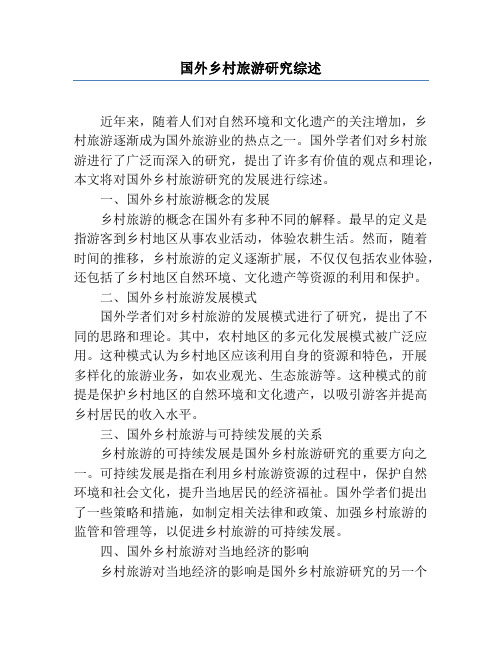
国外乡村旅游研究综述近年来,随着人们对自然环境和文化遗产的关注增加,乡村旅游逐渐成为国外旅游业的热点之一。
国外学者们对乡村旅游进行了广泛而深入的研究,提出了许多有价值的观点和理论,本文将对国外乡村旅游研究的发展进行综述。
一、国外乡村旅游概念的发展乡村旅游的概念在国外有多种不同的解释。
最早的定义是指游客到乡村地区从事农业活动,体验农耕生活。
然而,随着时间的推移,乡村旅游的定义逐渐扩展,不仅仅包括农业体验,还包括了乡村地区自然环境、文化遗产等资源的利用和保护。
二、国外乡村旅游发展模式国外学者们对乡村旅游的发展模式进行了研究,提出了不同的思路和理论。
其中,农村地区的多元化发展模式被广泛应用。
这种模式认为乡村地区应该利用自身的资源和特色,开展多样化的旅游业务,如农业观光、生态旅游等。
这种模式的前提是保护乡村地区的自然环境和文化遗产,以吸引游客并提高乡村居民的收入水平。
三、国外乡村旅游与可持续发展的关系乡村旅游的可持续发展是国外乡村旅游研究的重要方向之一。
可持续发展是指在利用乡村旅游资源的过程中,保护自然环境和社会文化,提升当地居民的经济福祉。
国外学者们提出了一些策略和措施,如制定相关法律和政策、加强乡村旅游的监管和管理等,以促进乡村旅游的可持续发展。
四、国外乡村旅游对当地经济的影响乡村旅游对当地经济的影响是国外乡村旅游研究的另一个重要方面。
研究表明,乡村旅游可以带动乡村地区的经济发展,提高当地居民的收入水平。
乡村旅游可以创造就业机会,促进农产品的流通和销售,推动乡村地区的产业升级和结构调整。
五、国外乡村旅游的发展挑战及应对策略在国外乡村旅游的发展过程中,也面临着一些挑战。
首先,乡村地区的基础设施相对落后,需要大量投资和改善。
其次,乡村地区的文化遗产需要有效保护和管理,以免过度开发和商业化。
此外,乡村旅游还面临着市场竞争和品牌建设的问题。
为应对这些挑战,国外学者们提出了加强政府支持、培养专业人才、加强乡村旅游品牌建设等应对策略。
外文翻译--旅游是罗马尼亚区域发展的重要经济因素

外文翻译--旅游是罗马尼亚区域发展的重要经济因素本科毕业论文外文翻译外文题目TOURISM – ECONOMIC GROWTH FACTOR AND ESSENTIAL ELEMENT IN REGIONAL DEVELOPMENT OF ROMANIA出处Metode statistice aplicate n analiza turismului rural Tez de doctorat 2009作者 Adrian Liviu SCUTARIU原文TOURISM – ECONOMIC GROWTH FACTOR AND ESSENTIAL ELEMENT IN REGIONAL DEVELOPMENT OF ROMANIAAdrian Liviu SCUTARIUAbstractThis paper aims to emphasize some aspects concerning the evolution of the tourism and its role in economic growth and regional development The first part presents a conceptual delimitation of tourism and the next parts are focused on the link of tourism with economic growth and regional development We also present the organizational frame of the regional development policy and the role of tourism in this policy objectives achievement and the final part brings some conclusions and some future development directions of tourism in Romania IntroductionThe tourism became at present time one of the most important industries in the world having an outstanding place in most of nationaleconomies The spectacular increase of this activity in terms of volume but also from the incomes point of view as well as its importance as exporting branch lead us in making the incursion that follows with the purpose of emphasize the role of tourism in the economic growth and regional development2Tourism – short conceptual delimitationsThe appearance of the tourism as an economic-organizatoric activityat national level took place in the second half of the twenty century in the same time with the inclusion in the services tertiary sector of some new branches of national economies generally called tourist industry The new economic theory of tourism recognized the link betweentourism and economic development of a country the tourism being treatedin a complex way not only as recreational trip but together with all the economic link that creates So at the present moment this notion includes a whole industry component of the services industry which contributes at the tourist demands satisfaction respectively hotels transports entertainmentThere were several different definitions given for tourism duringthe twenty century but we will focus on some present approaches accepted by most of the specialists of the fieldThe tourism can be shortly defined as being [Minciu Baron Neacu 1991 1993] an economic-social phenomenon specific for the modern civilization strongly anchored in the life of the society and influenced by its evolution with a high dynamism and having large social segments astarget It involves a large human capital and influences the evolution of the economy and societySo one can notice that in the tourism definition appeared more and more elements referring to the industry that handles the tourist need satisfaction fact also revealed by The Little Encyclopedic Dictionary which considers tourism as a side of the tertiary sector of the economy where the goal of the provided activity is the organization and ongoing of entertainment trips or of persons travels at various congresses and meetings including all the necessary activities for the consuming and services needs satisfaction of the customers"In order to clarify the aspects regarding the tourist phenomenon definition one can use the inductive method in order to get to a most possible comprehensive definition aiming to retain the main elementsthat are characteristic for the tourist activity [Neac u Baron Snak 2006 21]travel of the persons during their tripthe stay in a settlement out of their domicile permanent residenceof the person that travelsthe stay have a limited periodthe stay doesnt become a definitive residenceContinuing the anterior ideas we will mention a definition variant that includes the business travels too proposed by the professor dr Claude Kaspar the president of the International Association of the Scientific Experts in Tourism comST The tourism is an ensemble ofrelations and facts constituted from the travel and the stay of the persons for which the place of stay is not their home and not the principal place of their professional activityConsidering the role and the economic-social importance of theintern national tourism The World Tourism Organization WTO elaborated a definition of the national tourism so we can consider national tourist any person which visits a place that is not hisher usual residence situated inside hisher residence country and having a different purpose that a remunerated activity and with a staying of at least one night 3The place and role of tourism in the economyTourism as an important element of the tertiary sector and industry with huge potential has an increasingly role in the economy of a country being a factor which the economic growth is based onBy "economic growth" we mean a complex process involving the entire economic system which is determined by the results of economic activity and is considered the only factor that ensures the economic success in the long term of each stateThe tertiary or services sector has become prevalent in the postwar period its role becomes more important diversifying its activities in terms of content taking different forms of expression which have expanded and diversified ways of achieving social product thus becoming a significant component of the reproduction mechanism In developed countries this sector weightings are highThe services sector as any other sector experienced a development from early forms of the basic activities up to actual structures which are characterized by a imum utility for individuals and society Tourism as economic activity includes various services that derive from the basic ones information placement of tourist travels accommodation food selling offering treatments as well as leisure and entertainmentTourist offer increased both quantitatively and qualitatively giving rise to a genuine industry of tourism which requires the consideration of the tourism phenomenon as a growing distinct branch of the national economy component of the tertiary sector Separate treatment come from the complexity and specific nature compared to traditional branches of an economy However tourism is in close connection with the development of other sectors being a consequence branchAs socio-economic changes in the contemporary era have created and developed tourism this in turn bringing by default a specific demand for goods and services necessary to consolidate tourism product it stimulates some productive sectors such as industry agriculture construction transport trade communications culture healthcare etc From the expenditures of the tourist-consumer of goods and services which turns into money for the economic units of tourism industry transport accommodation food recreation treatment etc some goes directly to those units as profits and cash funds for pay their workers some goes to the state budget as taxes fees and another part reach other branchesof the economy as payment for goods delivered and services rendered by them for the needs of tourism industryConsidering tourist products consumed by foreign visitors during their stay international tourism will appear as a form of "invisible export" with advantages such as the duty free sale of products to foreign tourists into the country Therefore tourism has often a higher labor efficiency than classical export of goods and some of them consumed by tourists during the stay nor would be subject of classic export because of being perish of their costs of transport or other prohibitive measuresDue to the economic advantage of international tourism many developing countries have taken steps to develop their tourism industry this form of "invisible trade" in the economy could bring large quantities of currencySome statistical data come to support the previous statements The spectacular development of tourism in the last period can be observed also from the fact that the total number of tourists traveling abroad have increased from 1995 to 2008 becoming almost twice Figure no1 Source com UNWTO World Tourism Barometer Volume 7 No1 January 2009 Figure no1 International tourist arrivals millionsThe exemplification of the tourism place may also come from the fact that in The EU Member States about 20 million people are directly or indirectly involved in tourism the share of it in the creation of grossdomestic product of these countries being on average of about 4 [Postelnicu 1997 53]6 The role of tourism in the regional development objectives achievementThe regional development policy main objective is to reduce the economic and social disparities that exists between the various regions of EuropeSeveral of the regional development policies objectives can be achieved by boosting a field of activity that has some undisputed aces the tourism In this part of the paper we in tend to succinctly design some arguments for the ideas formerly expressed concerning the role of tourism in the regional developmentThe sustainable regional development must necessarily correlate and integrate the Romanian tourism between the other components of the local economy taking also into account that this clean industry does not affect the environment and generally does not requires big investments A good sustainable development project included in a regional development program supposes the less investments costs in this activity the more harmoniously the integration is made The tourism can become an important component of the economy which could cause important changes interritorial profile contributing at economic and social development of some regions less developedThe tourism can contribute more than other sectors at the achievement of some larger objectives established by governments aspriorities in the general interest of the citizens fighting against poverty life conditions improvement currency receipts increasing the intensification of the links between countries and even political purposesThe general objective of the regional development policy reducing existing regional imbalances with emphasis on balanced growth and revitalization of disadvantaged areas can be reached also by stimulating the areas with tourist potential for which the tourism would represent one of the less possibilities of standard of living and development increase especially in the rural areas The development of the tourism by the capitalization of the existing potential can lead also to the achievement of one of the ERDF objectives The ERDF financing explicitly supports the tourism development and the investments in the cultural patrimony including its protection and the natural ones with the condition of creating labor places7 ConclusionsIn the actual period the tourism became an outstanding element ofthe tertiary sector having an important role in the economy of a country and being one of the factors that contribute at the economic growth As we presented the tourism had an extraordinary development allover the world the number of tourists being twice as much than 15 years ago and the incomes from tourism increased considerably Its effects can be noticed in the development of its good and services suppliers branches the whole economy of the zone being stimulated in this waythrough the so-called multiplier effect At the tourism stimulation as branch that doesnt need important investments and dont affect environment the development policies can successfully contribute After a general presentation of the regional development coordinates in Romania we designed some development possibilities for the tourism with the help of the founds that can be accessed through this policy In Romania there is an important potential for the tourism development There are several causes for which the tourist activity level is not as high as the existing potential such as infrastructure low developed or the low quality of the services By accessing these founds several of the deficient aspectscan be improved The sums are considerable but it is necessary to increasethe absorption capacity for the available founds译文旅游是罗马尼亚区域发展的重要经济因素摘要本文旨在强调一些因素对旅游业发展演变的影响和旅游业在经济增长区域发展中的作用第一部分简要的介绍旅游业的概念然后接下来重点阐述旅游业与经济增长以及区域发展之间的联系我们也将介绍区域发展政策的组织目标和旅游业在实现这些政策目标中的作用最后部分得出结论并给出一些罗马尼亚旅游业未来的发展方向一引言如今旅游业成为世界上最重要的产业之一在很多国家的经济发展中有着显著的地位旅游业在数量上收入上都有剧烈的增加并成为重要的出口部门这让我们做如下的研究目的是强调旅游业在经济增长和区域发展中地位和作用二旅游业概念简介20世纪下半叶旅游作为国家层面的经济组织活动出现同时包括国民经济中一些新的分支的服务部门统称旅游业关于旅游业的新经济理论认为旅游业和一个国家的经济发展存在联系旅游业被认为是一种复杂的产业它不是只有休闲一个部门还联系着其他所有与之有关的经济部门因此现在旅游业的这一概念包含了整个行业包括那些为满足旅客需求的服务部门分别有住宿交通娱乐等20世纪关于旅游业有几种不同的定义我们集中介绍目前最被该领域专家所接受的一些定义旅游业可以被简短的定义为一种社会经济现象尤其是对现代文明来讲其演变过程对社会生活有着重大的影响旅游业具有高度的活力和众多的目标群体它涉及大量的人力资本并关系到经济和社会的发展[Minciu Baron Neacu 1991 1993]因此人们可以注意到在对旅游业进行定义时越来越多的理论研究把重点放在处理游客的满意程度上小百科词典也揭示了这个事实它是这样解释旅游业的第三产业的一部分提供活动的目标是组织和持续一项娱乐或者是各种私人的论坛会议为目的的旅行包括为满足消费者所有消费和服务的需要的活动为了弄清有关旅游现象的定义我们可以使用综合归纳法以获得一个最合适的定义旨在保留反应旅游活动性质的主要内容如下[Neacu Baron Snak 2006 21] 旅行途中的人离开居住地在外逗留停留时间有限没有明确住处的停留Claude Kaspar教授提出旅游还包括商务出行这一定义是对前面观点的延续他在comST中写道旅游业是人们旅行和住宿的整合他们所停留居住的地方既不是他们的家也不是他们从事专业活动的场所考虑到国际旅游对国家社会经济的重要性世界旅游组织对国际旅游进行了详细的定义人们为了休闲商务或其它目的离开他她们惯常住宿到另一个国家并逗留在那里这少超过一晚上旅游业在经济中的地位和作用旅游业做为第三产业的重要组成部分具有巨大的发展潜力它在国家经济发展中的作用日益增强成为经济增长的一个重要因素我们认为所谓的经济增长是整个经济系统中的一个复杂过程这是由经济活动决定的并被认为是确保每个国家经济长期成功的唯一因素经济增长是宏观经济长期持续增长的结果宏观经济增长包括国民生产总值国内生产总值和国民生产净额加上生产要素的使用效率和人均总值的增长其中也包括经济结构的调整二战后第三产业迅速发展其作用也越来越重要第三产业为实现社会产出的内容和形式也愈发的多种多样因此成为再生产机制的重要组成部分在发达国家第三产业这一部门的比重已经很高服务部门也像其他部门一样经历了从早期的基本活动发展到现在的复杂结构服务部门对私人和社会都具有最大效用旅游作为经济活动主要包括以下一些服务提供旅游信息旅游行程安排住宿餐饮休闲和娱乐旅游服务在数量和质量上的增加便出现了真正的旅游产业旅游产业被认为是国民经济的分支第三产业的组成部分相对于经济体系中一些传统的复杂具体的分支旅游业又有所不同但是作为一个重要的分支它与其他行业的发展联系密切正如当代社会经济的改变创造和发展了旅游业反过来为了巩固旅游产品又产生了对商品和服务的特殊需求这就刺激了一些生产部门如工业农业建筑业运输贸易通讯文化卫生等把商品和服务的消费收入变成旅游业交通住宿餐饮娱乐治疗等的各个经济部门的支出时一些直接进入这些单位的利润和用于支付工人工资的现金一些有的用于税收费用还有一部分用于支付旅游服务行业的其他经济部门如运输和其他有需要的部门的费用考虑到外国游客在逗留期间消费的旅游产品国际旅游业会出现一个隐形出口的优势如外国游客在该国购买免税的商品这就使旅游业在劳动效率上往往比传统的商品出口更高其中的一些旅游产品被游客逗留期间所消耗了也就不会出现传统的出口问题因为不存在运输或者其他禁止措施的费用因为国际旅游具有经济利益所以许多发展中国家加快发展他们的旅游产业这种无形贸易的经济形势可能带来大量的收益很多统计数据证实了前面的说法从1995年到2008年国家间旅游者总数将近翻了两番从这我们可以看出过去一段时间旅游业的巨大发展表1来源comUNWTO World Tourism BarometerVolume7No1January2009表1国际旅游者人数百万欧盟各成员国中约20亿人直接或间接参与旅游业创造的产值约占国内生产总值的4 [Postelnicu 1997 53]六旅游业在实现区域发展目标中的作用区域发展政策的主要目标是减少欧洲许多地区之间在社会经济上的差异区域发展政策的多个目标可以通过一个毫无争议的活动领域-旅游来实现在文章的这一部分我将简单的列举几个论据来论证前面的所说的旅游业在区域发展中的作用区域可持续发展与罗马尼亚旅游业有着必然的联系与地方经济的其他组成部分相比旅游业是一干净的产业对环境无害而且一般不需要太大的投资一个好的可持续发展规划应该是在一个区域发展规划中用较少的投资成本创造出更和谐的整体效应旅游业可以成为经济的重要组成部分它可以改变领土轮廓对欠发达区域经济和社会发展有重要促进作用政府通过考虑市民的整体利益而确定的目标对抗贫困提高生活环境增加收入加强各国间的联系和政治交流在实现上面的一些大目标上旅游业要比其他部门起的促进作用大区域发展政策的总体目标是减少目前区域间的不平衡尤其是平衡和振兴不发达地区这一总体目标也可以通过刺激一个地区的旅游业潜力来实现因此旅游业可以说是提高生活水平加快地方发展的可能性之一尤其是对农村地区通过大力开发现在具有潜力发展旅游业地区也可以实现ERDF的目标ERDF筹集资金明确表示是为投资支持旅游业的发展和文化遗产保护以期望为创造劳动场所提供条件七结论事实上旅游业已经成为第三产业中的突出部分在一国经济中起重要的作用并且是一国经济增长的因素之一如我们之前所提到的旅游业已经在世界各地以惊人的速度发展旅客人数是15年前的两倍旅游业收入也大幅度的增加货物和服务供应部门的发展就可以看出该区域的整体经济也因此受到了刺激这就是所谓的乘数效应在旅游业的刺激下各分支部门不需要大量的投资而且不影响环境发展政策也可以成功的做出贡献在对罗马尼亚区域发展做了总体的分析后我们设计了发展旅游业的可能性罗马尼亚存在很大的发展旅游业的潜力但是有几个问题以至于旅游活动的现有水平没有实际存在的潜力高如基础设施欠发达或服务质量低通过访问几个方面的缺陷可以得到改善虽然需要投入的款项相当大但是他是必要的可以增加吸引力1。
国外乡村旅游研究综述
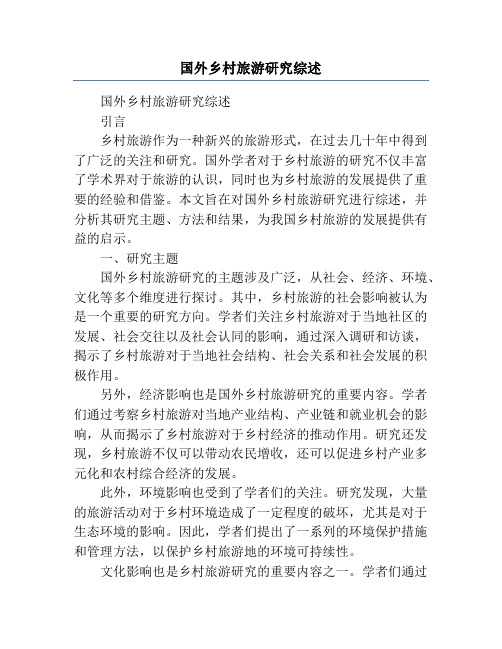
国外乡村旅游研究综述国外乡村旅游研究综述引言乡村旅游作为一种新兴的旅游形式,在过去几十年中得到了广泛的关注和研究。
国外学者对于乡村旅游的研究不仅丰富了学术界对于旅游的认识,同时也为乡村旅游的发展提供了重要的经验和借鉴。
本文旨在对国外乡村旅游研究进行综述,并分析其研究主题、方法和结果,为我国乡村旅游的发展提供有益的启示。
一、研究主题国外乡村旅游研究的主题涉及广泛,从社会、经济、环境、文化等多个维度进行探讨。
其中,乡村旅游的社会影响被认为是一个重要的研究方向。
学者们关注乡村旅游对于当地社区的发展、社会交往以及社会认同的影响,通过深入调研和访谈,揭示了乡村旅游对于当地社会结构、社会关系和社会发展的积极作用。
另外,经济影响也是国外乡村旅游研究的重要内容。
学者们通过考察乡村旅游对当地产业结构、产业链和就业机会的影响,从而揭示了乡村旅游对于乡村经济的推动作用。
研究还发现,乡村旅游不仅可以带动农民增收,还可以促进乡村产业多元化和农村综合经济的发展。
此外,环境影响也受到了学者们的关注。
研究发现,大量的旅游活动对于乡村环境造成了一定程度的破坏,尤其是对于生态环境的影响。
因此,学者们提出了一系列的环境保护措施和管理方法,以保护乡村旅游地的环境可持续性。
文化影响也是乡村旅游研究的重要内容之一。
学者们通过探究乡村旅游对于当地文化传统、乡土文化和族群文化的影响,从而提出了保护和传承乡村文化的建议。
研究发现,乡村旅游可以促进文化多样性的发展,同时也需要关注文化的保护与可持续发展。
二、研究方法国外乡村旅游研究所采用的研究方法多样,包括问卷调查、实地考察、深度访谈、案例分析等。
在方法上,学者们倾向于使用定性研究方法,以深入了解当地居民、游客和相关机构的真实想法和体验。
问卷调查是常用的研究方法之一,通过向当地居民和游客发放问卷,收集他们的意见、态度和对于乡村旅游的看法。
此外,学者们也常常进行实地考察,通过观察和记录不同乡村旅游地的特点和变化,进一步深入了解乡村旅游的发展状况。
近10年来国外乡村旅游研究特征及对中国的启示基于Elsevier

近10年来国外乡村旅游研究特征及对中国的启示基于Elsevier一、本文概述乡村旅游作为一种融合了农业、文化和旅游等多个领域的综合性产业,近年来在全球范围内得到了广泛的关注和快速发展。
本文旨在通过对近十年来国外乡村旅游研究特征的梳理和分析,探讨其对中国乡村旅游发展的启示。
具体而言,本文将首先概述国外乡村旅游研究的主要内容和趋势,然后分析这些研究特征对中国乡村旅游发展的潜在影响,最后提出针对性的建议,以期为中国乡村旅游的可持续发展提供有益的参考。
本文选择Elsevier数据库作为研究数据来源,主要是因为Elsevier是全球领先的学术出版商之一,其收录的文献质量高、覆盖面广,能够反映国外乡村旅游研究的最新进展和前沿动态。
通过对Elsevier数据库中相关文献的梳理和分析,本文将揭示国外乡村旅游研究的主要特征,包括研究主题、研究方法、研究趋势等方面,从而为中国乡村旅游的发展提供有益的借鉴和启示。
本文将以Elsevier数据库为基础,通过对近十年来国外乡村旅游研究特征的深入分析,探讨其对中国乡村旅游发展的启示。
这一研究不仅有助于提升中国乡村旅游的理论水平和实践能力,也有助于推动中国乡村旅游产业的可持续发展。
二、近10年来国外乡村旅游研究特征在过去的十年中,国外乡村旅游研究呈现出几个显著的特征。
研究视角日益多元化。
学者们不再仅仅从经济学或社会学的单一视角出发,而是更多地融合了地理学、环境学、文化学等多学科的理论和方法,对乡村旅游进行深入分析。
这种跨学科的研究趋势有助于更全面地理解乡村旅游的复杂性和多样性。
实证研究成为主流。
与早期以理论探讨为主的研究不同,近年来国外的乡村旅游研究更加注重实证分析。
学者们通过田野调查、问卷调查、深度访谈等方法,收集了大量的第一手数据,对乡村旅游的发展模式、影响因素、经济效益等进行了深入剖析。
这种实证研究的取向不仅提高了研究的科学性和可信度,也为乡村旅游的实践提供了有力的理论支持。
、国外乡村旅游发展典型案例乡村旅...

一、国外乡村旅游发展的借鉴(一)、国外乡村旅游发展典型案例乡村旅游起源于19世纪中叶的欧洲。
欧美洲开展乡村旅游的历史达百年以上。
在欧美一些发达国家,乡村旅游已具相当规模,并走上了规范发展轨道。
如爱尔兰、法国、西班牙、德国、美国等国家,政府把乡村旅游作为经济增长、扩大就业、避免农村人口向城市过度流动的重要手段,在资金、政策上给予大力支持。
许多国家和地区在乡村旅游发展的资源保护、产品开发、管理体系方面,走出了一条成功之路。
1、法国(1)发展历程:成立于1953年的法国农会(APCA)于1998年专门设立了“农业及旅游接待服务处”,并联合其他有关社会团体,建立了名为“欢迎莅临农场”的组织网络,有3000多户农民加盟,2004年,法国农村地区接待了全国28.2%的旅游者,本国公民在本国乡村旅游的消费额约为200亿欧元,影响巨大。
(2)产品类型:法国乡村旅游产品涵盖了农场客栈、农产品市场、点心农场、骑马农场、教学农场、探索农场、狩猎农场、暂住农场和露营农场等九大系列,法国郊区农业旅游也出现多种形式,包括家庭农场、教育农场、自然保护区、家庭农园等,活动类型多种多样。
(3)经验做法:①加强宣传。
法国出版了专门的宣传和指导手册,大力促销乡村旅游旅游。
②制定相关计划。
法国推出了的“农庄旅游”计划使1.6万户农家建立起了家庭旅馆。
③社区参与,实行本地化策略。
法国鼓励农民参与乡村旅游开发,加强了培训和引导,新兴的“绿色度假”每年可以给法国农民带来700亿法郎的收益,相当于全国旅游业收入的1/4。
2、美国(1)发展历程:美国有着悠久的乡村旅游传统,根据美国旅行行业协(Travel Industry Association of America)2006年对1300位乡村旅游者的抽样调查表明:亲近自然的乡村旅游最受旅游者青睐。
二战以后,乡村旅游成为中产阶级生活的一部分,假期经常在城边不贵的乡村食宿接待设施和私人农场中度过,旅游食宿设施的形式一般是乡村旅馆和农场上私人闲臵房间。
近二十年国外乡村旅游研究进展 文献分析
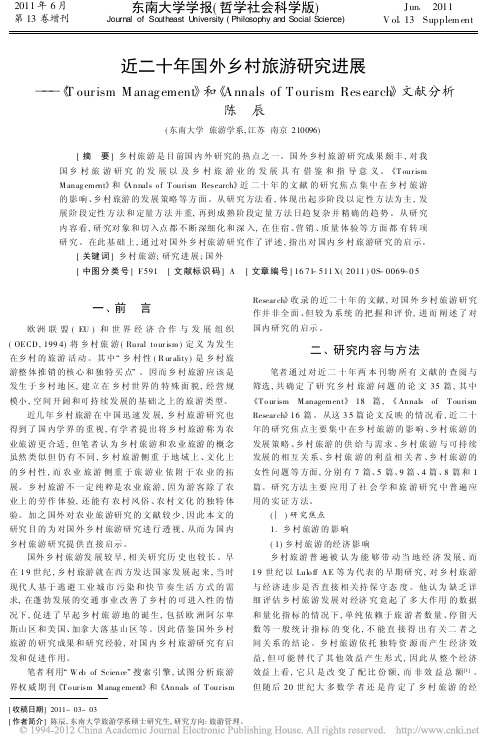
[ 收稿日期] 2011- 03- 03 [ 作者简介] 陈辰, 东南大学旅游学系硕士研究生, 研究方向: 旅游管理。
70
东南大学学报( 哲学社会科学版)
第 13 卷
济 带 动 作 用 。Briedenhann J 认 为 , 乡 村 旅 游 能 刺 激 并 带 动相关经济 发 展, 并能 提 升了 乡 村 居民 的 生活 质 量。 对于不发达地区, 通常也是未 开发的自然文 化地区, 乡 村旅 游 更 能 大大 吸 引 追 求 新 奇 体 验 的 旅 游 者。 此 外 , 乡 村旅 游 还 能 刺激 当 地 社 区 的 协 作 和 参 与。 社 区 参 与 , 与 公众 支 持 一起 , 又为 小 规 模 的 乡 村 旅 游 项 目 提供 了 发 展 的机 会[ 2] 。 Deller S 整 理 了 美 国 乡 村 地 区 199 0 - 20 00 年的 贫 困 率变 化 数 据 , 进 一 步 说 明 了 乡 村 旅 游和 休 闲 的 发展 能 降 低 贫困 率 、促 进 经 济发 展[ 3] 。
西班牙乡村旅游(翻译材料)
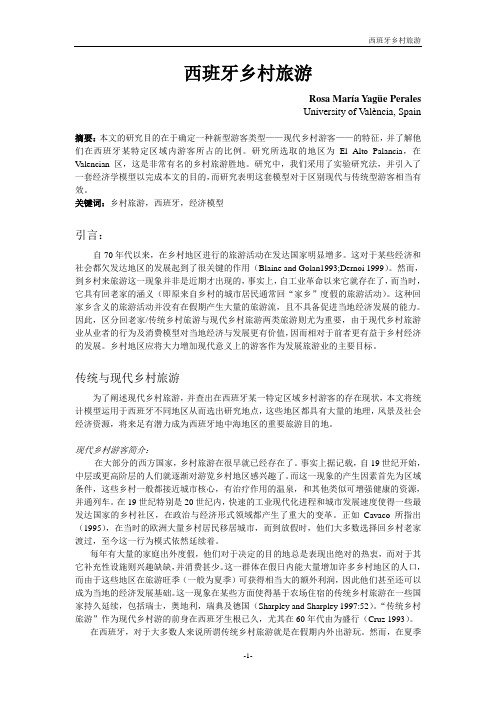
西班牙乡村旅游Rosa María Y agüe PeralesUniversity of València, Spain摘要:本文的研究目的在于确定一种新型游客类型——现代乡村游客——的特征,并了解他们在西班牙某特定区域内游客所占的比例。
研究所选取的地区为El Alto Palancia,在V alencian区,这是非常有名的乡村旅游胜地。
研究中,我们采用了实验研究法,并引入了一套经济学模型以完成本文的目的,而研究表明这套模型对于区别现代与传统型游客相当有效。
关键词:乡村旅游,西班牙,经济模型引言:自70年代以来,在乡村地区进行的旅游活动在发达国家明显增多。
这对于某些经济和社会都欠发达地区的发展起到了很关键的作用(Blaine and Golan1993;Dernoi 1999)。
然而,到乡村来旅游这一现象并非是近期才出现的,事实上,自工业革命以来它就存在了,而当时,它具有回老家的涵义(即原来自乡村的城市居民通常回“家乡”度假的旅游活动)。
这种回家乡含义的旅游活动并没有在假期产生大量的旅游流,且不具备促进当地经济发展的能力。
因此,区分回老家/传统乡村旅游与现代乡村旅游两类旅游则尤为重要,由于现代乡村旅游业从业者的行为及消费模型对当地经济与发展更有价值,因而相对于前者更有益于乡村经济的发展。
乡村地区应将大力增加现代意义上的游客作为发展旅游业的主要目标。
传统与现代乡村旅游为了阐述现代乡村旅游,并查出在西班牙某一特定区域乡村游客的存在现状,本文将统计模型运用于西班牙不同地区从而选出研究地点,这些地区都具有大量的地理,风景及社会经济资源,将来足有潜力成为西班牙地中海地区的重要旅游目的地。
现代乡村游客简介:在大部分的西方国家,乡村旅游在很早就已经存在了。
事实上据记载,自19世纪开始,中层或更高阶层的人们就逐渐对游览乡村地区感兴趣了。
而这一现象的产生因素首先为区域条件,这些乡村一般都接近城市核心,有治疗作用的温泉,和其他类似可增强健康的资源,并通列车。
【行业分析】罗马尼亚旅游业发展现状、特点及趋势分析_499

【行业分析】罗马尼亚旅游业发展现状、特点及趋势分析_499罗马尼亚旅游业发展现状、特点及趋势分析罗马尼亚地处欧洲东南部的巴尔干半岛,拥有丰富的自然资源,山地、丘陵和平原面积各占领土面积的三分之一,濒临黑海,海岸线长245公里,多瑙河有近三分之二流经罗境内,多瑙河三角洲为联合国教科文组织确定的世界自然文化遗产。
罗马尼亚同时是“吸血鬼”的故乡;全国各地遍布着历史悠久的教堂和修道院;历史上名人辈出,诗人爱米内斯库和音乐家埃内斯库响誉海内外;很多地方保持着千百年来的原生态风貌和习俗,人文财富也弥足珍贵。
但长期以来,由于缺乏推广、基础设施薄弱等原因,罗马尼亚的旅游业未能充分发挥潜力,发展远远滞后于周边国家。
特别是1989年以来,罗经济发展不振,投资环境欠佳,旅游业相应投入不足,国际收支长期入不敷出,最近几年才呈现出恢复的趋势。
去年,罗马尼亚首次实现了1990年以来经常项目下旅游收支的盈余。
一、罗马尼亚旅游业发展状况罗马尼亚的旅行和旅游业最近十年经历了相当困难的时期,国外游客数量急剧下降,本国游客流失严重,仅在1999年和2000年略有回升,受2001年911恐怖袭击和全球经济下滑影响,2001年和2002年外国游客数量又呈下降趋势。
最近几年才重新反弹,2003年和2004年分别增长了16,和18,。
与邻国和周边国家相比,2003和2004年间,到罗马尼亚旅游的外国游客数量增长最为迅速,但仍低于匈牙利和波兰的水平。
虽然去年罗马尼亚的海滨旅游受到了多雨阴冷天气的不利影响,但旅游业整体实现收入8.45亿欧元,同比增长了108,,是2000,2004年间年均收入的两倍多,近几年罗旅游业收入一直在4亿欧元左右徘徊。
去年旅游业经常项目国际收支余额为1.5亿欧元,实现了自1990年来的首次盈余。
2005年旅游收入占GDP的比重约为2.2,,达到历年来之最高。
虽然罗旅游业取得了长足发展,但与周边国家相比仍有很大差距。
尽管游客数量不断增加,但从旅游业收入看,罗马尼亚远远落后于匈牙利、捷克和克罗地亚。
纽马克交际翻译理论视角下旅游文本英译研究

现代商贸工业Modern Business Trade Industry2024年第7期作者简介:陈武(1980-),男,陕西周至人,硕士,西安石油大学外国语学院教授,研究方向:英语教育教学和翻译理论与实践研究;魏薇(1998-),女,安徽芜湖人,西安石油大学翻译硕士在读,研究方向:翻译㊂纽马克交际翻译理论视角下旅游文本英译研究陈㊀武㊀魏㊀薇(西安石油大学,陕西西安710065)摘㊀要:随着旅游业的迅速发展,越来越多的人选择 走出去 感受异国的风土人情㊂因此㊂旅游文本的翻译也显得日趋重要㊂探究旅游文本的英译,有利于更好地推动旅游业的发展,更好地传播中国声音㊂本文以5A 级旅游景区同里古镇的官网英译为例,运用纽马克交际翻译理论对旅游文本英译进行研究㊂希望能够为旅游文本的翻译提供一定的借鉴,推动中国旅游业的发展和繁荣㊂关键词:纽马克交际翻译理论;旅游文本;翻译方法中图分类号:F74㊀㊀㊀㊀㊀文献标识码:A㊀㊀㊀㊀㊀㊀doi:10.19311/ki.1672-3198.2024.07.0300㊀引言随着全球化的发展,中国与世界各国的联系日渐紧密㊂近年来,旅游业也发展迅速,越来越多的人选择 走出去 感受异国的风土人情㊂旅游是一种文化交流的方式,旅游文本是文化交流的桥梁㊂旅游文本属于信息性文本和呼唤性文本,而纽马克交际翻译也强调尽可能靠近读者,注重读者的感受㊂纽马克交际翻译理论与旅游文本的核心相契合㊂因此,旅游文本的翻译策略值得深入探究㊂同时旅游文本的翻译也可以为翻译工作者提供一定的参考和借鉴㊂1㊀旅游文本的特点旅游文本就是介绍旅游目的地当地的景点及风土人情,能够让游客快速了解到当地景点的独特之处,起到了宣传和引导作用㊂方梦之认为其特点是: 短小精悍,生动活泼,通俗易懂,信息量大又不失文学性㊁艺术性㊁宣传性和广告性 (方梦之,2008:275)㊂就汉语旅游文本和英语旅游文本而言,两者在词汇㊁句法上都具有很大的差异㊂1.1㊀词汇特点词汇特点是旅游文本区别于其他专业文本的一个重要特点㊂旅游词汇会涉及经济㊁政治㊁文化㊁宗教㊁历史㊁地理㊁风俗等各方面,旅游文本中还会涉及大量专有名词,如人名和地名㊂汉语旅游文本中的词汇多书面化,辞藻华丽,多采用四字格,以达到抒情和渲染的效果㊂而英语旅游文本中的词汇常用口语体,简洁明了,表达通俗易懂,注重文本的传递效果和应用性㊂1.2㊀句法特点汉英旅游文本的句法特点相比其他文本而言具有很大的差异㊂汉语是一种 意合 语言,句子成分之间的逻辑主要是通过语义来连接,句子结构比较自由㊂而英语是一种 形合 语言,句子成分之间的逻辑主要通过关联词等连接,注重语法规则㊂汉语的句式比较对仗工整,协调一致,而英语的句式比较自由松散,长短不一㊂2㊀纽马克交际翻译理论概述彼得㊃纽马克于1982年出版了‘翻译方法“㊂在这本书中,纽马克提出了交际翻译理论,并阐述其核心是语义翻译和交际翻译㊂他是这样定义语义翻译和交际翻译的: 语义翻译是在译语允许的情况下,尽可能地准确再现原文的上下意义,因而译文与原文的形式和风格更接近;而交际翻译是试图使译文对译语读者产生的效果尽量等同于原文对源语读者产生的效果㊂ (Approa-ches to Translation,2001,P34)语义翻译更靠近源文本,最大限度表达源文本的信息和内容,更接近源语的特点和习惯;然而交际翻译更靠近目的语文本,更能让目的语读者接受和理解㊂纽马克认为语义翻译注重接近源文本的效果,交际翻译注重读者的感受和理解程度㊂因此,交际翻译信息传递的效果更直接,译文更流畅,更符合读者的接受程度㊂语义翻译理论更强调译者对原文的尊重,因为原文的结构与译文的结构相似㊂在这种方法中,应遵循原文的语言特点和语法,以反映作者的思维过程㊂因此,交际翻译会更容易被读者接受,与语义翻译相比会比较通顺㊁简朴,译文一般比原文更长,文字更灵活㊂3㊀纽马克交际翻译理论在旅游文本中的应用纽马克将文本类型分为三大类,即表达性文本㊁信息性文本和呼唤性文本㊂其中,表达性文本指向了原文本的作者㊂它是指通过文本的语言,人们可以感受到作者的思想㊁愿望㊁观点或态度等情感,这就是语言的表达功能㊂在表达性文本中,首先要考虑原文的作者㊂㊃88㊃2024年第7期现代商贸工业Modern Business Trade Industry信息性文本主要是传达语言的信息功能,阐述相关事物的具体情况㊂该文本涉及自然科学㊁工商经济等相关领域,内容的真实性是其核心,语言不如真实性重要㊂就信息文本而言,在翻译时应以原文信息的表达为指导,以达到流畅的翻译㊂呼唤性文本主要考虑读者的反应,目的是吸引并引导读者按照作者的意图行动㊂有些文本属于这种类型,如产品说明㊁广告㊁小册子等,以读者为第一考量,充分利用目的语的优势,追求与源语相同的效果㊂旅游文本也更加注重读者的感受,即游客的感受,因此旅游文本翻译就是为了让读者充分了解到目的地独特的景点与独特的风土人情,激发读者的兴趣㊂这与纽马克的交际翻译理论核心相同㊂纽马克对交际翻译原则的定义是:交际翻译试图对读者产生一种与对原文读者最接近的效果㊂除此之外,纽马克还指出语义翻译适用于表达性文本的翻译,而交际翻译更适用于信息性文本和呼唤性文本的翻译㊂大多数学者将旅游文本划分为信息性文本和呼唤性文本,所以纽马克交际翻译理论适用于旅游文本的翻译㊂与文学翻译相比,旅游文本翻译是一种应用型翻译,旅游文本翻译更加注重译文的实用性㊂旅游文本的翻译就是要让游客接近目的地,因此,旅游文本的译文是否能让游客接近目的地,一定程度上会影响目的地的宣传效果㊂4㊀交际翻译理论视角下旅游文本英译研究纽马克的交际翻译理论在旅游文本的翻译中应用广泛,该论文将通过纽马克的交际翻译理论对现有文本的英文译文进行分析研究,下面以5A景区苏州同里古镇的官网译文为例㊂4.1㊀省译汉语旅游文本常常因为中华文化博大精深,源远流长,因此,辞藻华丽,多采用四字格,注重艺术美学,运用一些文化深厚的词对景点进行描述㊂而英文旅游文本一般用词简洁,注重信息的传达㊂在纽马克的交际翻译理论下,旅游文本的译文要以读者为主,因此,在翻译该类词的时候要简洁,传达信息即可㊂例如:ʌ原文ɔ新年伊始,初一到初五,同里四乡八邻的善男信女要做的第一件事,就是赶到古镇西南的 南观 支点罗汉,以祈求四季平安㊂ʌ译文ɔFrom Chinese New yearᶄs day to the fifth day of Chinese New Year many people come to"South Temple" to observe Lohan praying for peace all around the year.ʌ分析ɔ原文中 新年伊始,初一到初五 ,译文却省去了 新年伊始 ,只翻译了关键句 初一到初五 :From Chinese New yearᶄs day to the fifth day of Chinese New Year,示例中 同里四乡八邻的善男信女要做的第一件事,就是赶到古镇西南的 南观 支点罗汉 ,译文却省去了 要做的第一件事 古镇西南 ,只翻译了关键句赶到 南观 支点罗汉 :many people come to"South Temple"to observe Lohan.原文是同里古镇新年习俗的一个介绍,因此,只需要译出关键句,简洁明了即可,如果按照原文逐字翻译,只会让译文冗长乏味,甚至让游客误解㊂4.2㊀简译从思维方式来划分,中国人偏向具象思维,而英美人偏向抽象思维㊂因此在旅游文本中介绍一些事物时,中国文化倾向于用具体的形象进行思维阐述,而西方文化则强调用逻辑来阐述㊂根据纽马克交际翻译理论,对于此类中西方思维不同的语句,要采用简译法㊂例如:ʌ原文ɔ八月十五中秋节,此节同里人比较看重,家家户户都要供斗吃月饼㊂ʌ译文ɔOn Mid-Autumn Day Tongli people put more emphasis on Mid-Autumn Day burning joss sticks and hav-ing mooncake.ʌ分析ɔ原文中 八月十五中秋节 , 八月十五 和 中秋节 为同一个意思,因此进行了简译,只翻译了 中秋节 :Mid-Autumn Day;除此之外,这里的 家家户户 指代的就是 同里人 ,因此进行了简译,只翻译了 同里人 :Tongli people㊂这样使得译文符合西方的思维逻辑㊂4.3㊀释义法由于中西文化的差异,旅游文本中带有许多特定的中华文化的词,如果不对其进行解释性的翻译,那么译文则变得晦涩难懂,难以达到语言交际的作用和效果㊂根据纽马克交际翻译理论,对于此类词句,要采用释义法,使译文顺通,靠近读者㊂例如:ʌ原文ɔ据清嘉庆‘同里志“记载,从宋元明代起,同里已是吴中重镇㊂ʌ译文ɔAccording to records of Annals of Tongli of Jiaqing of the Qing dynasty Tongli has already been the strategic town of central Wujiang since Song Yuan and Ming Dynasties.ʌ分析ɔ原文中 吴中重镇 指的是吴江区中心的一个重要古镇,译文用解释性的方法将其译为 the strate-gic town of central Wujiang ,即传递出了字面意思,也表达出同里的重要地位㊂这里采用释义法能够让读者更加了解同里古镇的历史背景㊂5㊀结语旅游文本翻译与文化的传播息息相关,随着全球化的发展,世界各国文化之间的交流,旅游的发展也欣欣向荣,因此,旅游文本翻译有着举足轻重的地位㊂旅游㊃98㊃现代商贸工业Modern Business Trade Industry2024年第7期作者简介:杨莉(1982-),女,汉族,浙江杭州人,博士,浙江树人学院讲师,主要研究方向为国际贸易㊂文本往往承载着历史㊁宗教㊁政治㊁风俗㊁哲学等大量文化信息㊂旅游文本翻译也是文化传播的一个重要形式,提高旅游文本英译质量既能促进旅游业的发展,也能促进中国文化的传播㊂参考文献[1]Peter Newmark.Approaches to Translation [M ].Shanghai :Shanghai Foreign Language Education Press ,2001.[2]徐明玉.浅谈纽马克的语义翻译与交际翻译[J ].科技信息(科学教研),2008,(25).[3]夏康明,代礼胜.汉译英理论与实践 跨文化视角下的汉英翻译研究[M ].成都:四川大学出版社,2013.[4]吴霜,何泠静.交际翻译理论视角下文化负载词英译研究 以‘习近平谈治国理政“英译本为例[J ].汉字文化,2020,(23).[5]张志祥.旅游翻译中的交际规范[J ].上海翻译,2017,(02).[6]高嘉勇,韦玮.交际翻译视域下的旅游翻译英译研究[J ].河北旅游职业学院学报,2021,26(04).[7]王小兵,倪娜.浅谈旅游文本的语言特点与翻译[J ].郑州航空工业管理学院学报(社会科学版),2013,32(02).[8]李德超,王克非.平行文本比较模式与旅游文本的英译[J ].中国翻译,2009,30(04).[9]方梦之,毛忠明.英汉-汉英应用翻译教程[M ].上海:上海外语教育出版社,2005.国际结算课程思政教学实践研究讲好中国贸易故事杨㊀莉(浙江树人学院,浙江杭州310015)摘㊀要:以国际结算专业课程为研究对象,以中国贸易故事为切入点建构课程思政教学主线,探讨讲好中国贸易故事的课程思政教学改革实践,以期实现将知识传授与价值引领相结合,在专业课程中贯穿价值观培养㊂并以信用证业务教学为例,探讨了讲好贸易故事的课程思政教学组织过程㊂关键词:课程思政;国际结算;贸易故事;信用证业务中图分类号:F74㊀㊀㊀㊀㊀文献标识码:A㊀㊀㊀㊀㊀㊀doi:10.19311/ki.1672-3198.2024.07.0310 引言课程思政是扎根中国大地办教育,坚持社会主义办学方向的重要途径㊂2014年课程思政被首次提出,2020年6月,教育部正式颁布的‘高等学校课程思政建设指导纲要“中提出高校要从学科建设㊁课程教学㊁教师能力等方面开展课程思政建设㊂近10年来,课程思政的理论研究与实践创新已取得较丰富的成果㊂新时代高校课程思政在内涵理解㊁元素挖掘㊁教学方式和教学实践都呈现新的发展趋势(蒲清平和何丽玲,2021)㊂在教学中实现知识传授与价值引领的统一,使大学生在获得科学知识的同时树立正确的价值观,是课程思政改革需要关注的核心问题(王新华和王娜,2021)㊂课程思政改革中也存在内涵挖掘不到位㊁认识差异较大㊁课程体系欠缺㊁方法选择困难等问题㊂在高校中,专业课程的比重较高,学生对于自己的专业课有着特殊的情感和兴趣,专业领域的典型案例往往对学生更具有吸引力和感染力,更容易引起学生的情感共鸣㊂因此,发挥专业课程的思政功能,对于培养社会主义事业的合格建设者和接班人具有无可替代的重要作用(王东维,2023)㊂讲故事㊁讲案例是学生普遍喜欢和认同的一种教学方式㊂2013年8月习近平总书记在全国宣传思想工作会议上强调 要讲好中国故事,传播好中国声音 ㊂新形势下,讲好中国故事不仅是中国舆论的追求方向,也是实现高校思想政治理论课的功能,是对高校思想政治理论课教师课堂教学的基本要求(樊英杰,2019)㊂通过摆事实㊁讲故事的形式将课程思政的理念表现出来,避免说教㊁喊口号式思政教育,便能自然深刻地潜移默化影响学生的思想㊂但是课程思政又不只是简单地讲故事,而要结合课程内容的具体知识点进行巧妙地融入,讲出 故事背后的故事 ㊂国际结算是国际经济与贸易和国际商务专业的专业基础平台课程㊂国际结算的理论与实务是随着国际贸易的发展而发展的,与经济发展和贸易实践密不可分㊂教师梳理国内外贸易实践中的故事,提炼中国贸易故事中的思政元素,系统地开展国际结算课程思政,对于培养同时具备扎实的专业基础知识㊁专业技能和良好的职业道德㊁正确的价值取向的从事国际贸易的专业人才具有十分重要的意义㊂㊃09㊃。
罗马尼亚旅游指南
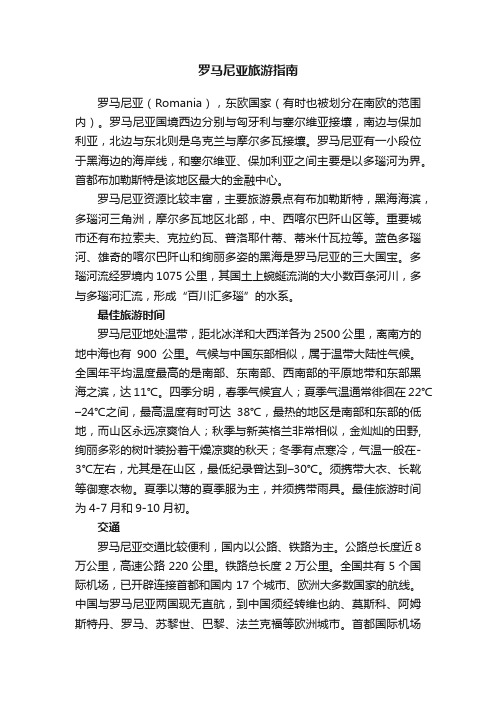
罗马尼亚旅游指南罗马尼亚(Romania),东欧国家(有时也被划分在南欧的范围内)。
罗马尼亚国境西边分别与匈牙利与塞尔维亚接壤,南边与保加利亚,北边与东北则是乌克兰与摩尔多瓦接壤。
罗马尼亚有一小段位于黑海边的海岸线,和塞尔维亚、保加利亚之间主要是以多瑙河为界。
首都布加勒斯特是该地区最大的金融中心。
罗马尼亚资源比较丰富,主要旅游景点有布加勒斯特,黑海海滨,多瑙河三角洲,摩尔多瓦地区北部,中、西喀尔巴阡山区等。
重要城市还有布拉索夫、克拉约瓦、普洛耶什蒂、蒂米什瓦拉等。
蓝色多瑙河、雄奇的喀尔巴阡山和绚丽多姿的黑海是罗马尼亚的三大国宝。
多瑙河流经罗境内1075公里,其国土上蜿蜒流淌的大小数百条河川,多与多瑙河汇流,形成“百川汇多瑙”的水系。
最佳旅游时间罗马尼亚地处温带,距北冰洋和大西洋各为2500公里,离南方的地中海也有900公里。
气候与中国东部相似,属于温带大陆性气候。
全国年平均温度最高的是南部、东南部、西南部的平原地带和东部黑海之滨,达11℃。
四季分明,春季气候宜人;夏季气温通常徘徊在22℃–24℃之间,最高温度有时可达38℃,最热的地区是南部和东部的低地,而山区永远凉爽怡人;秋季与新英格兰非常相似,金灿灿的田野, 绚丽多彩的树叶装扮着干燥凉爽的秋天;冬季有点寒冷,气温一般在-3℃左右,尤其是在山区,最低纪录曾达到–30℃。
须携带大衣、长靴等御寒衣物。
夏季以薄的夏季服为主,并须携带雨具。
最佳旅游时间为4-7月和9-10月初。
交通罗马尼亚交通比较便利,国内以公路、铁路为主。
公路总长度近8万公里,高速公路220公里。
铁路总长度2万公里。
全国共有5个国际机场,已开辟连接首都和国内17个城市、欧洲大多数国家的航线。
中国与罗马尼亚两国现无直航,到中国须经转维也纳、莫斯科、阿姆斯特丹、罗马、苏黎世、巴黎、法兰克福等欧洲城市。
首都国际机场距市区约15公里,乘831路公交车可到首都广达机场。
持外交和公务护照可免签证。
- 1、下载文档前请自行甄别文档内容的完整性,平台不提供额外的编辑、内容补充、找答案等附加服务。
- 2、"仅部分预览"的文档,不可在线预览部分如存在完整性等问题,可反馈申请退款(可完整预览的文档不适用该条件!)。
- 3、如文档侵犯您的权益,请联系客服反馈,我们会尽快为您处理(人工客服工作时间:9:00-18:30)。
外文翻译原文Romanian rural tourism development a case study: rural tourism inMaramuresMaterial Source:International Journal of Business Research, July, 2007Author:Adina L. Negrusa, Smaranda A. Cosma, Marius Bota ABSTRACTMany countries considered tourism as a real and sustainable support for their economic development. The tourism was considered a really chance for Romania. Despite this, the travel and tourism economy contribution to Romanian GDP varied around 2 per cent in the last 10 years.Due to an underdeveloped and neglected road infrastructure, to the lack of financing resources and to the lack of interest of local and central authorities for tourism development, regions fitted for ecotourism and rural tourism--like Maramures--failed to attract tourist, neither foreign, nor Romanian. The situation improved slowly since 1996, after the decision of European Community to finance the rural development (including rural tourism) in Romania through Phare programs and--by the end of 1990s--through SAPARD programs.Our research is focused on identifying the potential of development of these branches of tourism into international market and the motivation for practicing.The present paper analyzes the rural tourism potential in Romania and Maramures region, its evolution since 1990 and the prospective strategy needed to a better promotion of this region on the European tourist market.Keywords:Rural tourism;Strategy of development;SWOT analysis;International market1. INTRODUCTIONWTO used rural tourism concept for defining that tourism product "that gives to visitors a personalized contact, a taste of physical and human environment of countryside and as far as possible, allow them to participate in the activities, traditions and lifestyles of local people." According to WTO it is considered that take part from rural tourism a wide range of activities like: climbing, riding, adventure tourism, educational travel, sport and health tourism, arts and heritage tourism.Lane (1994) outlines the specific features of rural tourism. First of all it is concentrated in rural areas. Second it is based on small-scale and traditional activities and enterprises, environmental aspects and heritage. Third it is relating to small-scale buildings and settlements and forth it relies on traditional qualities of the countryside and develops slowly under the control of local people. Lastly it reflects the complexity of the rural environment and has several different forms.We define rural tourism as that form of tourism offered by people from rural areas, with accommodation on small-scale and with the implication of important components of their rural activities and customs of life.In European countries rural tourism became an important segment of tourism (Hall D.2000,2004). The EuroGites conference in 2003 reported that there were more than 200 thousand providers of Farm and Village Tourism registered in Europe, with more than 2 millions beds. A Euro barometer survey on "Europeans on Holiday (1997-1998)" showed that more and more people are interested not only in "sampling" new places but also in discovering different forms of tourism, placing greater emphasis on quality products, on more environmentally and culturally sensitive forms of tourism and on shorter but more frequent trips, while a significant number of Europeans (23%) choose the countryside as the most preferred tourism destination (EC, 1998).Rural tourism is a trend in Europe and is in a continuous growing. WTO estimates an annual growth of approximately 6% of rural tourism comparing with 2% growth of tourism in general. In a number of Southern and Eastern European countries the growth was strongly, more than 20%, due to some transformations which took place in the countryside and agriculture as a results of recently involved in the European Union integration.The rural space in Romania accounted almost 89% from the entire territory and for 47% of the population their home is situated in the rural area. Romania's rural economy is dominated by agriculture of which the predominant feature is the high share of subsistence farms, mainly producing for their own consumption and only marginally for the market. Because of the domination of this form of agriculture the rural economy remains poorly integrated into the market economy.After 1990 the tourism was considered a really chance for Romanian economic development. Romania has a harmonious and diverse landscape and, from the tourist point of view, could be considered one of the beautiful and resourceful places inEurope. Romania, also, has a rich traditions and culture. But until now our country did not become--as it was intended--a well known tourist destination.Some analysts consider--and we intend to be in accordance with their opinions--that the delay in privatization combined with many problems in tourism infrastructure, transport infrastructure and public services postponed the real development of this sector. (Moraru, 2005 and Societatea Academica din Romania, 2004).2. ROMANIAN RURAL TOURISM--A GENERAL OVERVIEWRegarding the rural development we identified that important measures were planned in The National Strategy on Sustainable Development. This gives priorities to investments in infrastructure (irrigation), the development of green tourism, the creation of family farms of an "optimal size" (between 50 and 100 ha) and securing the food supply by developing agricultural production and re-launching industrial sectors related to agriculture such as farming machinery. Under these circumstances it is obviously why that rural tourism became an important strategy for development both rural regions and tourism economy.The Romanian rural area disposes of reach tourist potential to be found both in mountain and hill areas and in the Black Sea Cost and Danube Delta zone. Each area presents an interest from the ethnographic point of view and folklore heritage, having also particularity in the traditional customs.The National Association of Rural Ecological and Environmental Tourism founded in 1994 and a member of the European Federation of Rural Tourism--EUROGITES, is the national organization for tapping the potential of rural tourism. In the present in Romania there are approximately 13 000 of rural communities which could offer settlement for accommodation. The main purpose of the ANTREC organization was to identify, develop and promote the Romanian hospitality and rural tourism. Its basic declared functions are:--to identify and promote the rural tourism potential,--to organize professional training for the travel agencies at the countryside,--to organize advertising campaigns for trips and holidays spent in guest houses and farm houses,--to promote rural tourism in the international market due to participation in fairs and exhibitionsANTREC succeeded to involve a great number of members (about 2000) and to run tourism activities appreciated in the domestic market and abroad. TheEUROGITES Catalogue is a yearly catalogue where are included the most representative agro-tourism farms and in the European rural tourism network. Beside France, Germany, Belgium, Ireland, etc., could be seen traditional houses from the Rucar-Bran Pass, Maramures, Bucovina, Praid, and the Danube Delta.The lodging structure for rural tourism has two main specific forms:--rural pensions, with a maxim of 10 rooms and 30 places--agro-tourism pensions, being part of the inhabitants' farm and having the production capacity to provide 30% of the ingredients for meal and food Furthermore we analyze the development of rural tourism in Romania based on the number of rural pensions and their capacity. First of all we used for this issue, statistical date about the number of rural tourism boarding houses, which it is considered an important indicator of the development of this sector.It is obviously that the rural tourism became an important alternative form of tourism in Romania. From a ponder of 2% in 1996 rural tourism boarding houses represent in 2004 more then 22%. The increasing demand for rural tourism positively influenced the interest of entrepreneurs and managers for this type of business.To this favourable evolution contributes also the legislation launched by the government from 1996 to 1999, having as main objective to support this kind of business. For example an important action applied in 1997 was focused on: priority to allocation of land, priority to install telecommunications infrastructure, free technical assistance, free advertising in informational supports edited by Tourism Ministry, no taxes for ten years (Bran F.1997). Even if these facilities were suspended in 1999, the trend has been constantly the same.We were interested also to analyze the evolution of capacity of these types of accommodation in the same period of time. Using statistical data about the number of places offered by rural pensions, this evolution is presented in the figure 1. The annual average growth is 31%, higher then the annual average growth of the units' number, due to the fact that the development of rural tourism concentrated on the intensive and sustainable increasing strategies. It can be observed that in 2003 was registered an increasing of the capacity more then double, 51%, which correspond also to the peak of units' number growth. Analyzing the capacity per units resulted that in general a rural tourism boarding house offers an average of 10 places, which means a settlement with an average of 5 rooms. Like we stated before this result means the accommodations offer are at small-scale.Due to the small-scale of the settlement also the number of accommodations in rural pensions is insignificant comparing with the total number of accommodations, just 1.7%. The evolution of tourists arrivals reflects that the number of foreign tourists which choose rural tourism for their accommodation increasing each year, with an annual average of 28%. This means a continuous increasing interest for the Romanian rural tourism. In general the number of staying overnight in rural pensions, which is approximately 2.7 nights, remained constant without significant differences between internal and foreign tourists. Because of that the indicator of net using tourist accommodation capacity for rural pensions is lower, about 14.6%, comparing with hotel's one of 40%.Despite of the global development of the Romanian rural tourism, in the last years could be identified a regional disparity. In order to evaluate the disparities development of rural tourism in Romania we made an analysis on the number of units accommodation in rural areas spread on region bases. We take into account the 8 regions of development, created by the National Agency for Regional Development in order to promote a better and an appropriate development of each part of the country. Based on the results we concluded that three region are known for rural tourism and also have the potential to be promoted into the international tourism market. These are Centre (44%), North-West (13.4%) and North-East (12.3%) regions. Also the most important flows of tourists within rural tourism are recorded there.These regions accumulated an important economical capital in the last years and significant internal and international investments. Other regions and settlements having a high rural tourism potential remain in an uncertainly position on the tourists market because of the weak developed territorial infrastructure, the absence or weak development of the tourist arrangements or due to a weak and unorganized marketing activity.In the international tourism market until now Romania could not developed a competitive tourist products. Comparing with the neighbour countries based on the foreign tourist arrivals in 2005, Romania came in the 5th position, after Poland, Hungary, Croatia and Czech Republic. It is interesting to remark that 95% from the foreign tourists came from European countries. In the top of the European Union countries which represent the lager tourism market for Romania could be identified: Germany with a market share of 13.49%, Italy with 12.63%, France having a rise of the market share to 8% and United Kingdom at about 5.6% market share.The most important issues related to the capacity of Romanian tourism in the international market in the last 6 years are the growth trend of the foreign tourists' arrivals and the high rate of increasing foreigners in the rural tourism, the annual average is around 34%. In this context we make a correlation between this trend and the results of a set of studies done by our tourism ministry in order to analyse the international potential market. Based on them we concluded that in general in the European market there is a high interest for the following areas from Romania: Transylvania coming first for the medieval cities and ancient castles; Bucovina is in the second position, being interest for the painted monasteries and traditional artefacts; Maramures was in the 3rd position due to the rural tourism and cultural heritage In conclusion we can say that the Romanian tourism image in the international market starting to be identifiable and related with the elements of cultural, eco and rural tourism. In this circumstances we appreciate that the promotion strategy in European market should be concentrated on these elements, highlighting the areas connected.3. POTENTIAL DEVELOPMENT OF RURAL TOURISM IN MARAMURESMaramures is located in north-north western Romania. The historic Maramures region is less than 500 square km. To the south lie the volcanic ranges of Oas, Gutai and Tibles. The Rodna range guards Maramures eastern border. To the northeast rises the wild and unexplored range of the Maramures Mountains. The northern border of Maramures and Romania is the Tisa River.The historical Maramures is the most fitted region for ecotourism and rural tourism due to its beautiful mountain regions combined with the villages situated along the four valleys--Mara, Cosau, Iza and Viseu. Maramures is in the 3rd position on the national hierarchy taking into account the number of rural pensions and in the 4th position based on rural tourists units in general.In the historical Maramures the natural beauties motivate the tourist looking for camping and ecotourism to go up in the mountains. Tourists looking just for rural tourism are entering an interesting world of Maramures villages where history, traditions, the art and music are present in the every day life of the local people.A culture of wood workers and craftsmen was born and lives to this day. This work could be seen in its wooden churches carved since 14th century. These churches are today a main tourist attraction. Known throughout the world, these churches represent a unique element of wooden architecture on the Europeancontinent. Also immense wooden gate marks the entrance to the individual Maramures homestead. In the past, the dimension of the gate suggested the family status in the community and the idea is still present today. Various objects of wood are used in every house from simplest wooden spoons and yarn spindles to wooden bottles or gourds used at the weddings. As guests in the Maramures houses, tourists can see how blankets and rugs are weaved from thick wool and are decorated with traditional models.Other points of interest for tourists in Maramures are the traditions. These traditions are connected with the main religious events, but also tourists can see more common customs like weddings and christenings. In Maramures the traditions are present all around the year. For all the celebrations, the traditional costumes are worn. Every village has its own particular models and colour for costumes. During the celebrations also the music is present, the main 'artist' being the village fiddlers and their special instruments generating particular tunes. Of course, the music is a little bit different from village to village.Maramures region has an important contribution to attract more foreign tourists to Romania. In 2005 registered an approximate rapport of one foreign tourist to 3 internal tourists (32%), higher then the regional average which is 28.2%. Analyzing the evolution of tourist arrivals in Maramures resulted that the ponder of accommodation in rural pensions represent 5% from the total tourist arrivals in the county, higher in comparison with the national ponder of 3.4%.To develop tourism in a region, are needed to be developed products and services, marketing and promotion. Rural development plans often contain a wide range of aims and measures. For determining the possible strategic alternatives needed for Maramures area in the process of attracting foreign tourists we use SWOT matrix. Knowing that the first step in strategic planning is situational analysis, we try to combine external opportunities and internal strengths and external treats and internal weaknesses identified in the table bellow:4. CONCLUSIONSHistorical Maramures region has a great potential for rural tourism and the other forms of tourism like natural tourism, agro tourism and cultural tourism and there are enough natural resources, traditions and customs combined with the hospitality of local people. The steps to follow for a sustainable form of tourism in Maramures could be:> a better understanding about the common features of ecotourism and rural tourism and how these influence the tourist products and how these products could be promoted in connection with agro tourism, natural tourism and cultural tourism;> to improve the access to financing sources for these forms of tourism; Maramures is not suitable for mass-tourism because this could have a negative impact on the environment; due to this, the lodging capacities should not be larger than 10 rooms for a pension or an agricultural farm. The Romanian banks consider these businesses to have a very high risk and were reluctant to lend money for these activities--due mainly to the lack of information about the supply and demand in this area. The financing resources used in tourism sector remains under 10% from the total internal resources available.> a better distribution of information about the financing sources offered for rural development (including rural tourism) by the European Community through PHARE, SAPARD, RICOP and ISPA programs.an improvement of the educational and training process for those who are or want to be involved in the rural tourism activities. The training was welcomed and considered to be useful for those interested in rural tourism activities. The quality improvement for the accommodation capacities, especially in rural areas. the quality mentioned above must be completed with the Romanian people capacity to communicate in foreign languages; in Maramures, from the total agro-tourist pensions presented by Antrec, in 38%> only Romanian language is spoken and in 33% only one foreign language is spoken (mainly French).> another important component to attract tourists are to diversity the leisure activities; these are barely mentioned by the prints; Maramures can offer a wide range of activities to spend an exciting holiday from natural tourism and eco-tourism to cultural and theme tourism, opening a window toward every day life, with its celebrations and customs.译文罗马尼亚乡村旅游发展的个案研究:以马拉暮莱斯为例资料来源: 国际商业研究杂志.2007(7)作者:安迪纳·尼古拉斯,丝玛然德·科斯玛和玛瑞斯波特摘要许多国家认为旅游是促进国家经济切实可持续发展的一个行业。
